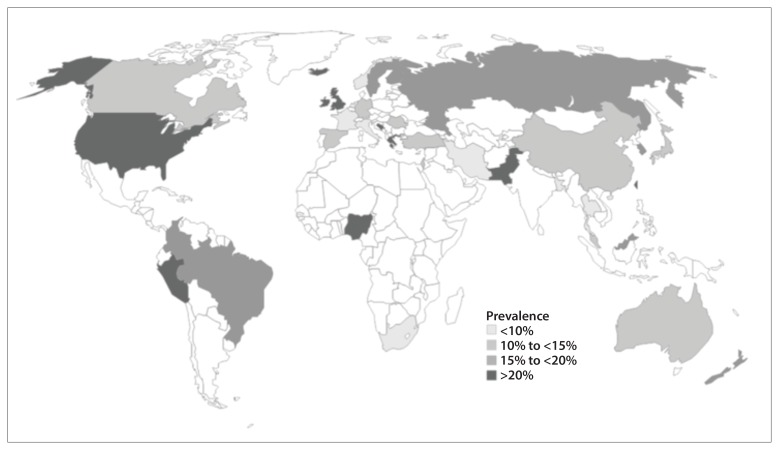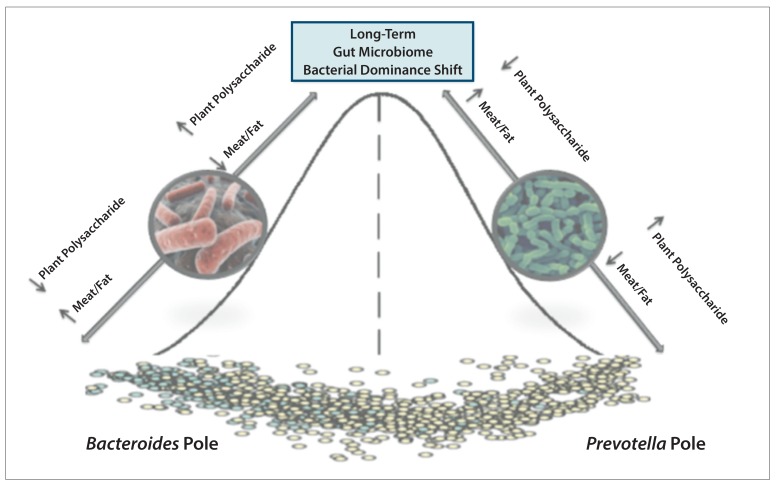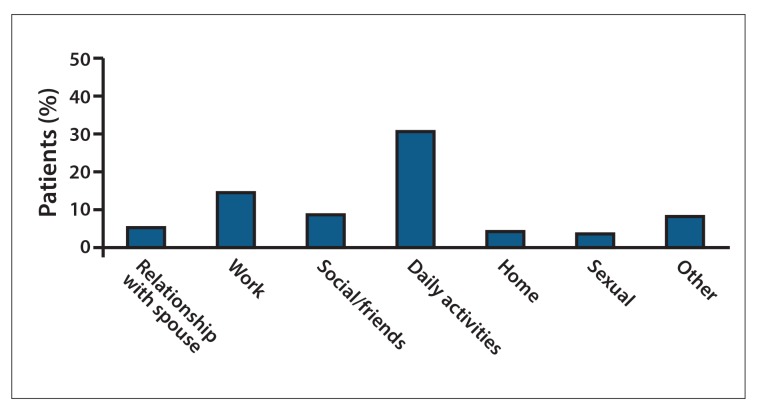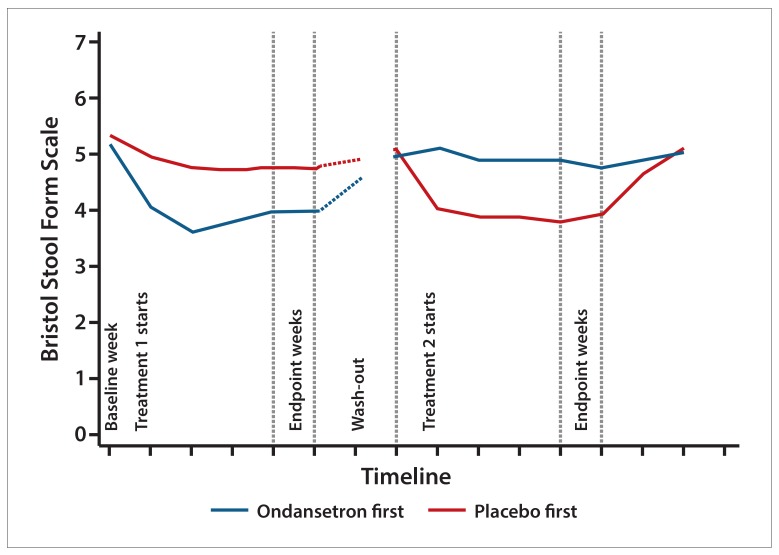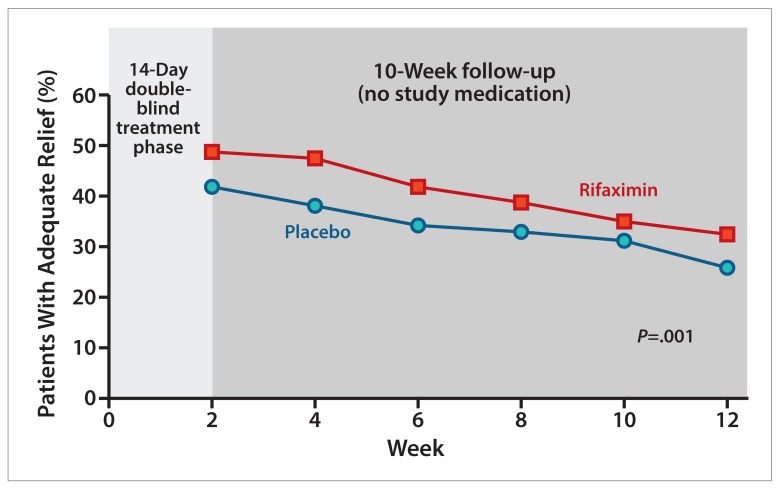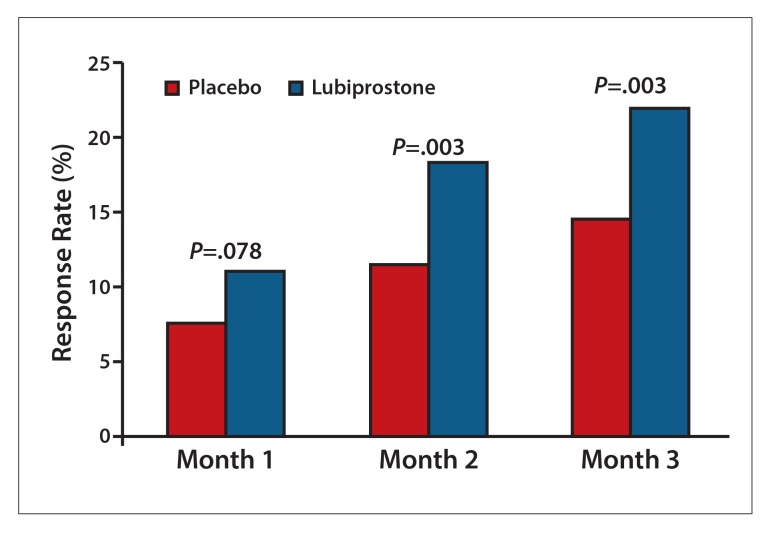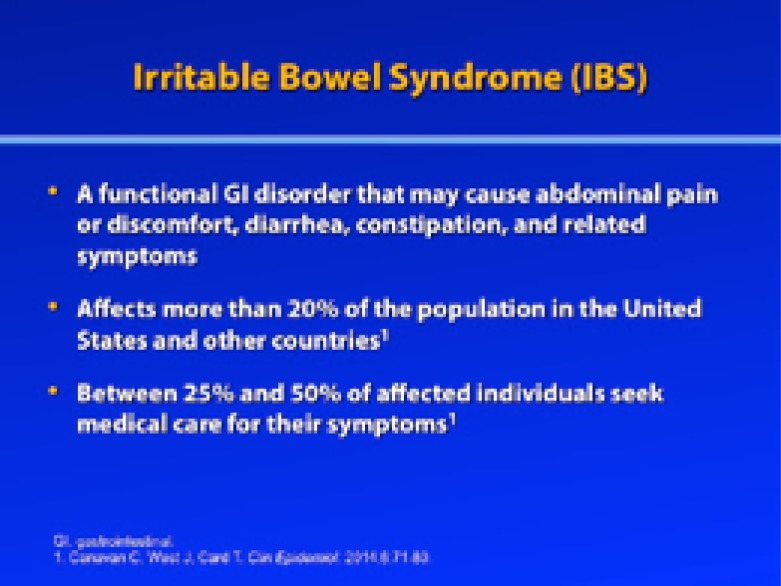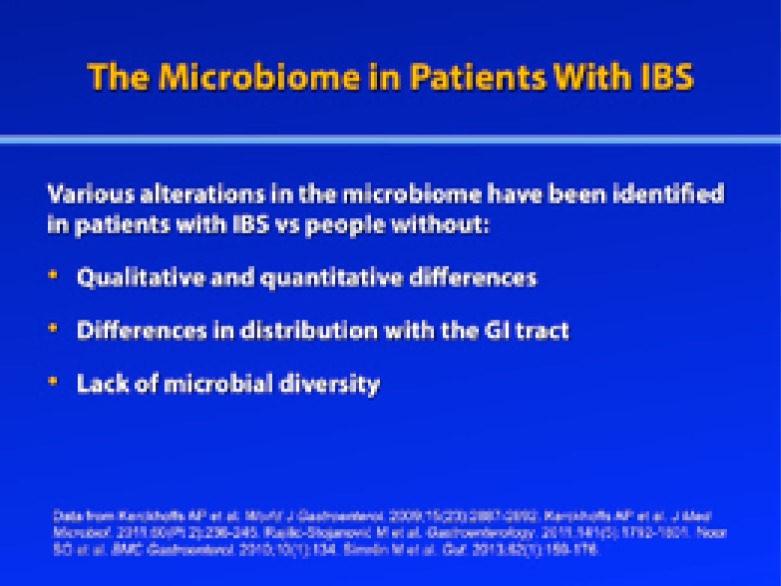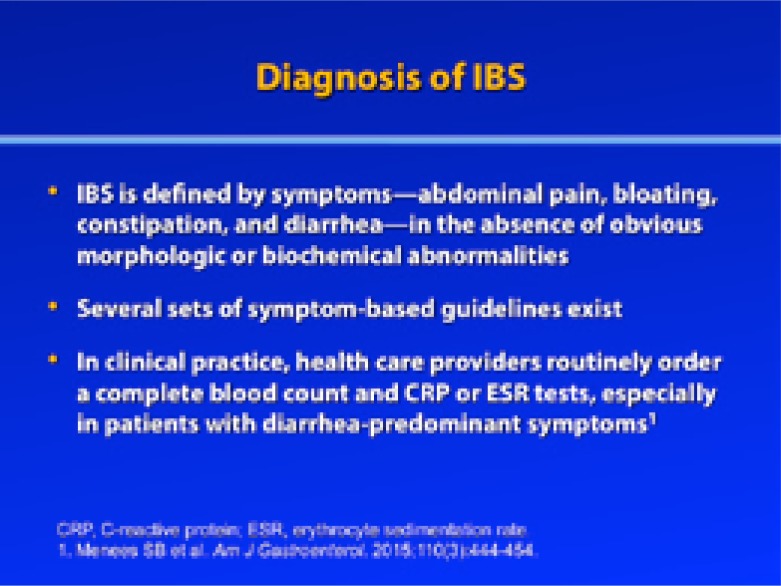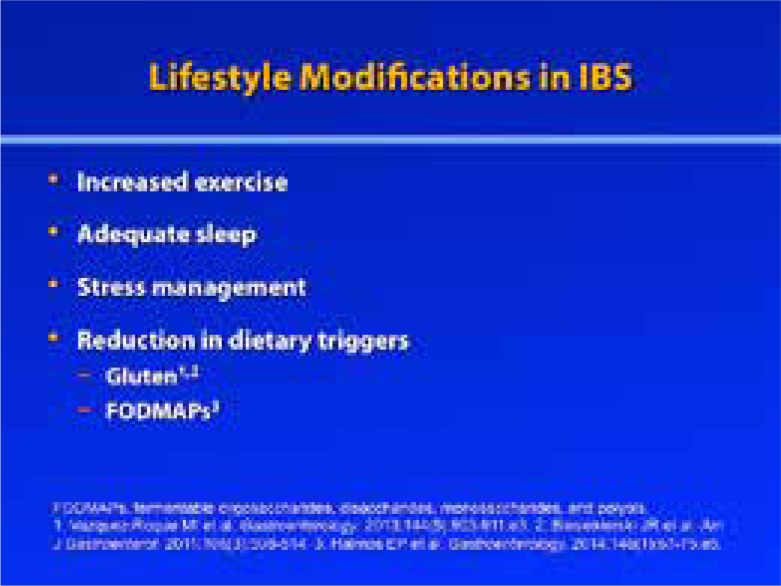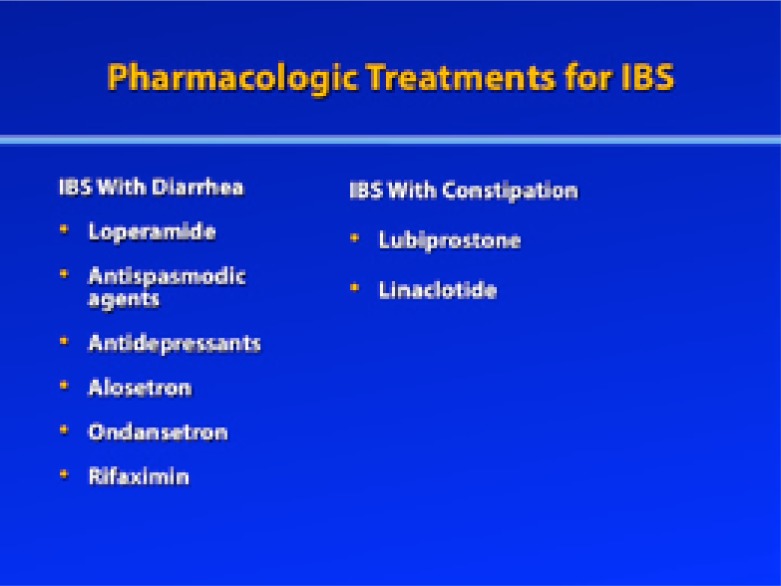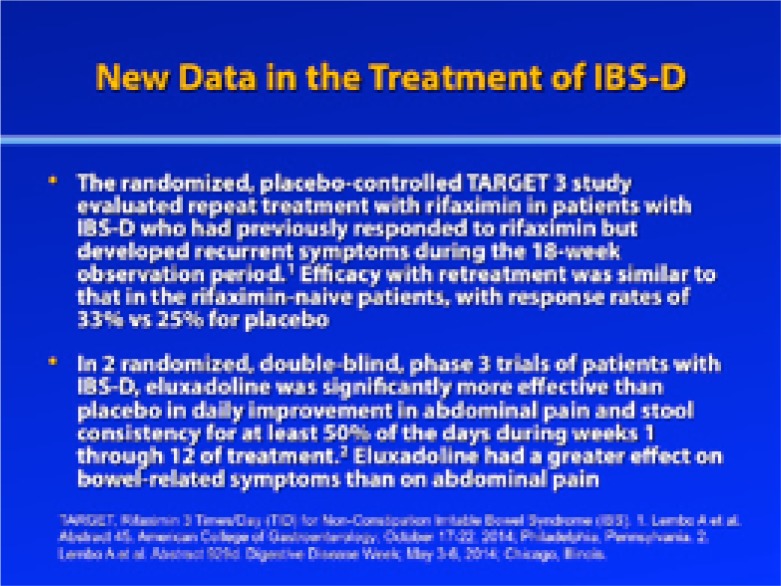Abstract
Irritable bowel syndrome (IBS) is a functional gastrointestinal disorder associated with abdominal pain, diarrhea, constipation, or a mix of symptoms. The pathophysiology of IBS is not completely understood but appears to involve genetics, the gut microbiome, immune activation, altered intestinal permeability, and brain-gut interactions. There is no gold standard for diagnosis. Several sets of symptom-based guidelines exist. Treatment strategies for IBS may include both nonpharmacologic and pharmacologic approaches. Lifestyle modifications that aim to improve exercise, sleep, diet, and stress may be warranted. Recent data suggest that a gluten-free diet and a diet low in fermentable oligosaccharides, disaccharides, monosaccharides, and polyols (FODMAPs) may benefit some patients. For patients with diarrhea-predominant IBS, treatment options include the synthetic peripheral μ-opioid receptor agonist loperamide, antispasmodic agents, antidepressants, serotonin 5-HT3 antagonists, and the gut-specific antibiotic rifaximin. Ongoing research is evaluating the use of probiotics. For patients with constipation-predominant IBS, therapeutic strategies may include dietary fiber, laxatives, and the prosecretory agents lubiprostone and linaclotide. Research is continuing to optimize the use of available agents and evaluating new approaches to further improve the care of patients with IBS.
Current Insights into the Pathophysiology of Irritable Bowel Syndrome
Irritable bowel syndrome (IBS) is a functional gastrointestinal (GI) disorder that may cause abdominal pain or discomfort, diarrhea, constipation, and related symptoms. IBS is common, with prevalence reaching more than 20% in some countries (Figure 1).1 In western countries, rates of IBS are higher in women than in men.1 Only a fraction of affected individuals—between 25% and 50%—seek medical care for their symptoms.1
Figure 1.
Worldwide prevalence of irritable bowel syndrome.
Adapted from Canavan C et al. Clin Epidemiol. 2014;6:71-80.1
IBS is categorized into subgroups based on the dominant bowel-related symptom(s). These subgroups include IBS with diarrhea (IBS-D), IBS with constipation (IBS-C), and IBS with mixed or alternating diarrhea and constipation (IBS-M).2 The IBS subgroups are defined based on stool consistency, which has been shown to correlate with constipation and diarrhea better than stool frequency.2 Stool consistency is also a better surrogate for colon transit, with hard or lumpy stools predicting slow transit and loose or watery stools predicting more rapid transit (Table 1).3 Identifying the relevant subgroup is important for selecting the appropriate diagnostic tests and treatment strategies.
Table 1.
Accuracy of Stool Form in Predicting Delayed Transit
| CTT by Wireless Motility Capsule | WGTT by Wireless Motility Capsule | WGT by 5-Day ROM Study | ||||
|---|---|---|---|---|---|---|
| Stool Form (value on BSFS)a | Sensitivity (%) | Specificity (%) | Sensitivity (%) | Specificity (%) | Sensitivity (%) | Specificity (%) |
| 1 | 14 | 100 | 15 | 100 | 10 | 99 |
| 2 | 64 | 90 | 65 | 89 | 55 | 87 |
| 2.5 | 82 | 83 | 85 | 82 | 80 | 81 |
| 3 | 86 | 72 | 90 | 71 | 80 | 69 |
| 4 | 100 | 22 | 100 | 21 | 95 | 20 |
The average value over 2 to 5 days.
BSFS, Bristol Stool Form Scale; CTT, colonic transit time; ROM, radio-opaque marker; WGT, whole-gut transit; WGTT, whole-gut transit time.
Data from Saad RJ et al. Am J Gastroenterol. 2010;105(2):403-411.3
Although an IBS diagnosis including subtype is based upon symptoms present at the time of evaluation, the majority of patients experience some change in their symptoms over time, most often from IBS-C or IBS-D to IBS-M. Less frequently, patients alternate between IBS-C and IBS-D.
Comorbidities are common in IBS and can affect both the GI tract and other systems. A substantial proportion of patients fulfill criteria for IBS and also have symptoms suggestive of other functional GI disorders, including functional chest pain, heartburn, dyspepsia, and/or abdominal pain.4 Patients with IBS are also more likely than the general population to have other pain-related disorders, including migraine headache, fibromyalgia, and chronic pelvic pain.5 The presence of GI manifestations and global pain disorders suggests a shared pathophysiology, perhaps as a consequence of altered pain processing. Depression and anxiety are also more common in IBS patients and influence their illness experience.5
IBS is a costly disorder that has tremendous consequences on a societal level. Patients with IBS tend to utilize more health care services than the general population, as measured by nearly any parameter (eg, outpatient office visits, diagnostic testing, and costs attributable to over-the-counter or prescription medications).6 In the United States, estimated annual direct costs attributable to IBS exceed $10 billion.7 Estimated indirect costs, which exceed $20 billion, are primarily due to missed work—either absenteeism or presenteeism (reduced productivity while at work).7
Pathophysiology of Irritable Bowel Syndrome
The pathophysiology of IBS is not fully understood. When the pathophysiology of IBS was first considered in the 1950s and 1960s, the symptoms were largely attributed to psychiatric illness. In the 1960s, the focus shifted toward abnormalities in GI motility as a cause for IBS.8 In the 1970s and 1980s, the concept of visceral hypersensitivity was proposed, suggesting that IBS patients might perceive any of a number of stimuli differently, leading to GI symptoms.9 In the 1990s, the concept of the brain-gut axis and related abnormalities gained popularity.10 In the past 10 years, there have been tremendous advances in our understanding of how these different factors might fit together in the pathophysiology of IBS.11
Genetics, the microbiome, immune activation, and altered intestinal permeability may all contribute to the pathogenesis of IBS,11 and a biopsychosocial model has been proposed to account for the influence of interactions between the brain and the gut.12 Factors early in life that may contribute to the development of IBS include impaired family dynamics (eg, abuse or maternal deprivation), acute GI infection, and, potentially, the use of systemic antibiotics.11 These factors may predispose individuals to the development of abnormalities in enteric nerve dysfunction, motility, visceral sensation, and brain-gut interactions, as well as mentalhealth disorders. Later in life, environmental triggers may contribute to the development, or at least the exacerbation, of symptoms in patients with underlying abnormalities in motility, function, and sensation. In susceptible individuals, stimuli such as food or stress can be important triggers for the abdominal pain and altered bowel habits characteristic of IBS.
Recently, there has been a significant focus on the role of the gut microbiome in the pathophysiology of IBS.13 When considering the role of the microbiota, it is helpful to recognize the significant presence of bacteria in the human body. The number of bacteria far exceeds that of the host somatic cells. At least 500 to 1000 species of bacteria have been identified in the human body. Moreover, 60% of the fecal biomass consists of bacteria.
The microbiome plays a critically important role in the normal development and function of the GI tract. Animals raised in a germ-free environment exhibit abnormal GI tract development and functioning.14 A variety of factors influence the gut microbiome, including genetics, diet, exposure to GI pathogens, and medications (Figure 2).15 The effects of antibiotics on the microbiome are well known, and other medications may also have an impact.
Figure 2.
Long-term dietary changes can alter the gut microbiome.
Adapted from Voreades N et al. Front Microbiol. 2014;5:494.15
Various alterations in the microbiome have been identified in patients with IBS, who show qualitative and quantitative differences, differences in distribution within the GI tract, and a lack of microbial diversity compared with people without IBS.16-20 The clinical relevance of these early observations, and their role in the cause vs effects of IBS, are not yet known.
Multiple studies have shown an association between IBS and small intestinal bacterial overgrowth (SIBO).21 There are substantial limitations in the sensitivity and specificity of the breath tests used to detect SIBO.20 Nonetheless, these findings are useful for exploring the hypothesis that patients with IBS may have abnormalities in the microbiome, not only in the colon but also in the small bowel. Supporting this hypothesis are studies suggesting that the microbiome in the small bowel of IBS patients may be altered both quantitatively and qualitatively.16
Emerging evidence also suggests that intestinal permeability is impaired in patients with IBS, lending possible credence to the concept of the “leaky gut.”22 Some patients with IBS demonstrate markers of increased immune activation, including higher mast cell concentrations and activation, altered immune markers, and elevated levels of cytokines, including tumor necrosis factor—α.23
Patients who have experienced severe acute infectious gastroenteritis (bacterial, viral, or parasitic) are at increased risk of developing long-term IBS symptoms, a condition known as postinfectious IBS.24,25 Perhaps most clinically relevant today are the differences in the natural history of patients who develop IBS after an infection. IBS is typically a chronic condition, but when it develops after an infection, symptoms will resolve in approximately two-thirds of patients in 5 to 6 years.26 Thus, it is important to inform patients with postinfectious IBS that they are likely to improve over time, regardless of the interventions offered. At present, there is no evidence to suggest that one therapy is better than another for postinfectious IBS. In the future, however, there may be therapies specifically for postinfectious IBS that affect immune activation or the microbiome.
Multiple factors may contribute to the development of IBS, including a genetic predisposition in the presence of dysbiosis (abnormalities in the microbiome); environmental triggers, such as stress; psychologic disorders; diet; medications; and infections. Together, these factors may lead to alterations in intestinal permeability that permit increased antigen presentation, promoting immune activation. These events could lead to altered sensation and functioning of the GI tract, causing the symptoms of IBS. It has been hypothesized that systemic chemokines and cytokines may lead to the extraintestinal symptoms, such as fatigue, joint pain, and skin rash, often reported by patients with IBS.27
References
- 1.Canavan C, West J, Card T. The epidemiology of irritable bowel syndrome. Clin Epidemiol. 6:71–80. doi: 10.2147/CLEP.S40245. [DOI] [PMC free article] [PubMed] [Google Scholar]
- 2.Longstreth GF, Thompson WG, Chey WD, Houghton LA, Mearin F, Spiller RC. Functional bowel disorders. Gastroenterology. 2006;130(5):1480–1491. doi: 10.1053/j.gastro.2005.11.061. [DOI] [PubMed] [Google Scholar]
- 3.Saad RJ, Rao SS, Koch KL, et al. Do stool form and frequency correlate with whole-gut and colonic transit? Results from a multicenter study in constipated individuals and healthy controls. Am J Gastroenterol. 2010;105(2):403–411. doi: 10.1038/ajg.2009.612. [DOI] [PubMed] [Google Scholar]
- 4.Frissora CL, Koch KL. Symptom overlap and comorbidity of irritable bowel syndrome with other conditions. Curr Gastroenterol Rep. 2005;7(4):264–271. doi: 10.1007/s11894-005-0018-9. [DOI] [PubMed] [Google Scholar]
- 5.Whitehead WE, Palsson O, Jones KR. Systematic review of the comorbidity of irritable bowel syndrome with other disorders: what are the causes and implications? Gastroenterology. 2002;122(4):1140–1156. doi: 10.1053/gast.2002.32392. [DOI] [PubMed] [Google Scholar]
- 6.Longstreth GF, Wilson A, Knight K, et al. Irritable bowel syndrome, health care use, and costs: a U.S. managed care perspective. Am J Gastroenterol. 2003;98(3):600–607. doi: 10.1111/j.1572-0241.2003.07296.x. [DOI] [PubMed] [Google Scholar]
- 7.Hulisz D. The burden of illness of irritable bowel syndrome: current challenges and hope for the future. . J Manag Care Pharm. 2004;10(4):299–309. doi: 10.18553/jmcp.2004.10.4.299. [DOI] [PMC free article] [PubMed] [Google Scholar]
- 8.Connell AM. The motility of the pelvic colon. II. Paradoxical motility in diarrhoea and constipation. Gut. 1962;3(4):342–348. doi: 10.1136/gut.3.4.342. [DOI] [PMC free article] [PubMed] [Google Scholar]
- 9.Delvaux M. Role of visceral sensitivity in the pathophysiology of irritable bowel syndrome. Gut. 2002;51(suppl 1):i67–i71. doi: 10.1136/gut.51.suppl_1.i67. [DOI] [PMC free article] [PubMed] [Google Scholar]
- 10.Mayer EA, Tillisch K. The brain-gut axis in abdominal pain syndromes. Annu Rev Med. 2011;62(1):381–396. doi: 10.1146/annurev-med-012309-103958. [DOI] [PMC free article] [PubMed] [Google Scholar]
- 11.El-Salhy M. Irritable bowel syndrome: diagnosis and pathogenesis. World J Gastroenterol. 2012;18(37):5151–5163. doi: 10.3748/wjg.v18.i37.5151. [DOI] [PMC free article] [PubMed] [Google Scholar]
- 12.Spence MJ, Moss-Morris R. The cognitive behavioural model of irritable bowel syndrome: a prospective investigation of patients with gastroenteritis. Gut. 2007;56(8):1066–1071. doi: 10.1136/gut.2006.108811. [DOI] [PMC free article] [PubMed] [Google Scholar]
- 13.Bye W, Ishaq N, Bolin TD, Duncombe VM, Riordan S. Overgrowth of the indigenous gut microbiome and irritable bowel syndrome. World J Gastroenterol. 2014;20(10):2449–2455. doi: 10.3748/wjg.v20.i10.2449. [DOI] [PMC free article] [PubMed] [Google Scholar]
- 14.Smith K, McCoy KD, Macpherson AJ. Use of axenic animals in studying the adaptation of mammals to their commensal intestinal microbiota. Semin Immunol. 2007;19(2):59–69. doi: 10.1016/j.smim.2006.10.002. [DOI] [PubMed] [Google Scholar]
- 15.Voreades N, Kozil A, Weir TL. Diet and the development of the human intestinal microbiome. Front Microbiol. 2014;5(494) doi: 10.3389/fmicb.2014.00494. [DOI] [PMC free article] [PubMed] [Google Scholar]
- 16.Kerckhoffs AP, Samsom M, van der Rest ME, et al. Lower Bifidobacteria counts in both duodenal mucosa-associated and fecal microbiota in irritable bowel syndrome patients. World J Gastroenterol. 2009;15(23):2887–2892. doi: 10.3748/wjg.15.2887. [DOI] [PMC free article] [PubMed] [Google Scholar]
- 17.Kerckhoffs AP, Ben-Amor K, Samsom M, et al. Molecular analysis of faecal and duodenal samples reveals significantly higher prevalence and numbers of Pseudomonas aeruginosa in irritable bowel syndrome. J Med Microbiol. 2011;60(pt 2):236–245. doi: 10.1099/jmm.0.022848-0. [DOI] [PubMed] [Google Scholar]
- 18.Rajilić-Stojanović M, Biagi E, Heilig HG, et al. Global and deep molecular analysis of microbiota signatures in fecal samples from patients with irritable bowel syndrome. Gastroenterology. 2011;141(5):1792–1801. doi: 10.1053/j.gastro.2011.07.043. [DOI] [PubMed] [Google Scholar]
- 19.Noor SO, Ridgway K, Scovell L, et al. Ulcerative colitis and irritable bowel patients exhibit distinct abnormalities of the gut microbiota. BMC Gastroenterol. 2010;10(1):134. doi: 10.1186/1471-230X-10-134. [DOI] [PMC free article] [PubMed] [Google Scholar]
- 20.Simrén M, Barbara G, Flint HJ, et al. Rome Foundation Committee. Intestinal micro-biota in functional bowel disorders: a Rome foundation report. Gut. 2013;62(1):159–176. doi: 10.1136/gutjnl-2012-302167. [DOI] [PMC free article] [PubMed] [Google Scholar]
- 21.Saad R, Chey WD. Breath testing for small intestinal bacterial overgrowth: maximizing test accuracy. Clin Gastroenterol Hepatol. 2014;12(12):1964–1972. doi: 10.1016/j.cgh.2013.09.055. [DOI] [PubMed] [Google Scholar]
- 22.Odenwald MA, Turner JR. Intestinal permeability defects: is it time to treat? Clin Gastroenterol Hepatol. 2013;11(9):1075–1083. doi: 10.1016/j.cgh.2013.07.001. [DOI] [PMC free article] [PubMed] [Google Scholar]
- 23.Hughes PA, Zola H, Penttila IA, Blackshaw LA, Andrews JM, Krumbiegel D. Immune activation in irritable bowel syndrome: can neuroimmune interactions explain symptoms? Am J Gastroenterol. 2013;108(7):1066–1074. doi: 10.1038/ajg.2013.120. [DOI] [PubMed] [Google Scholar]
- 24.Thabane M, Kottachchi DT, Marshall JK. Systematic review and meta-analysis: the incidence and prognosis of post-infectious irritable bowel syndrome. Aliment Pharmacol Ther. 2007;26(4):535–544. doi: 10.1111/j.1365-2036.2007.03399.x. [DOI] [PubMed] [Google Scholar]
- 25.Beatty JK, Bhargava A, Buret AG. Post-infectious irritable bowel syndrome: mechanistic insights into chronic disturbances following enteric infection. World J Gastroenterol. 2014;20(14):3976–3985. doi: 10.3748/wjg.v20.i14.3976. [DOI] [PMC free article] [PubMed] [Google Scholar]
- 26.Thabane M, Marshall JK. Post-infectious irritable bowel syndrome. World J Gastroenterol. 2009;15(29):3591–3596. doi: 10.3748/wjg.15.3591. [DOI] [PMC free article] [PubMed] [Google Scholar]
- 27.Talley NJ, Fodor AA. Bugs, stool, and the irritable bowel syndrome: too much is as bad as too little? Gastroenterology. 2011;141(5):1555–1559. doi: 10.1053/j.gastro.2011.09.019. [DOI] [PubMed] [Google Scholar]
Diagnostic Strategies in Irritable Bowel Syndrome
IBS is a complex disorder, and a gold standard for diagnosis does not exist. The diagnosis continues to perplex health care providers, due to several factors: symptoms are nonspecific, patients are heterogeneous, and the evaluation criteria vary across specialties and health care providers. Different beliefs regarding the etiology of IBS have led to inconsistent diagnostic strategies. Guidelines continue to change as new evidence is added to an ever-expanding database.
Currently, IBS is defined by symptoms—abdominal pain, bloating, constipation, and diarrhea—in the absence of obvious morphologic or biochemical abnormalities. These symptoms lead to a broad differential diagnosis. Nevertheless, when diagnostic criteria are fulfilled and alarm features are absent, the need for diagnostic testing should be minimal.
The Importance of a Confident Diagnosis
In an international survey of 1966 adult patients diagnosed with IBS, the diagnosis was made a mean 6.6 years (±9.7 years) after symptoms began.1 Confirmation of a positive diagnosis of IBS is important for several reasons. A diagnosis can reassure patients about the nature of their symptoms and avoid unnecessary testing, procedures, and surgeries.2 Patients with IBS are more likely to undergo unnecessary cholecystectomy, appendectomy, and hysterectomy than matched controls.3 An accurate and timely diagnosis will also allow clinicians to present the management options and initiate treatment. Persistent symptoms can reduce work productivity (Figure 3) and further increase the economic burden of this prevalent disorder. Lastly, a diagnosis can help patients feel confident about future treatment decisions and optimize the use of health care resources.
Figure 3.
Impact of irritable bowel syndrome on various aspects of life, as reported in a survey of 261 patients.
Adapted from Lacy BE et al. Aliment Pharmacol Ther. 2007;25(11):1329-1341.2
The symptoms of IBS are nonspecific. Disorders that can mimic IBS include inflammatory bowel disease (IBD), celiac disease, lactose intolerance, microscopic colitis, malabsorptive disorders, GI infections, dietary intolerances, and hormonal disturbances. The first textbook of American gastroenterology, published in 1944, advocated a diagnosis of exclusion.4 An assumption underlying this strategy was that a battery of normal test4 would reassure the patient that nothing was wrong. Unfortunately, the use of extensive testing proved to be expensive and misguided. In a study of patients who underwent colonoscopy for their GI symptoms, a normal result did not allay patients’ fears that they were suffering from a severe organic illness.5 In addition, invasive tests (eg, colonoscopy) place the patient at some risk.
Guidelines
For the diagnosis of IBS, many gastroenterologists use the definition provided by the American College of Gastroenterology: abdominal pain with disordered defecation.6 This definition captures the key clinical IBS characteristic of abdominal pain while highlighting the changes in bowel habits. It has not yet been validated.
More detailed guidelines are also available, including the Manning criteria7 and the Rome criteria.8 None are ideal. The Rome III diagnostic criteria require recurrent abdominal pain/discomfort at least 3 days per month over 3 months, with symptom onset at least 6 months before diagnosis and the presence of at least 2 of the following symptoms: improvement of pain/ discomfort with defecation, onset associated with a change in stool frequency, or onset associated with a change in stool appearance. IBS subtyping is based on the predominant stool pattern using the Bristol Stool Form Scale.9 The Rome III criteria are commonly used in research studies but not in clinical practice.
Diagnostic Tests
Bristol Stool Form Scale
The Bristol Stool Form Scale was developed in the 1990s in the Bristol Royal Infirmary in England.9 The authors described 7 types of stool:
Type 1: Separate hard lumps, like nuts (hard to pass).
Type 2: Sausage-shaped, but lumpy.
Type 3: Like a sausage, but with cracks on its surface.
Type 4: Like a sausage or snake, smooth and soft.
Type 5: Soft blobs with clear-cut edges (passed easily).
Type 6: Fluffy pieces with ragged edges, a mushy stool.
Type 7: Watery, no solid pieces, entirely liquid.
Stool types 3 and 4 are considered normal. Constipation is indicated by types 1 and 2. Diarrhea is indicated by types 6, 7, and (to some degree) 5. When the Bristol Stool Form Scale was first published, the authors postulated that it could be used as a surrogate marker for colon transit, but that concept has since been challenged. Nonetheless, the Bristol scale provides a convenient way for patients to describe their bowel habits, and it is routinely used in clinical trials. In IBS-C patients, more than 25% of bowel movements are types 1 or 2. In patients with IBS-D, more than 25% are types 6 or 7. In patients with the mixed subtype of alternating constipation and diarrhea, more than 25% of bowel movements are types 1 or 2, and more than 25% are types 6 or 7.
Blood Tests
If a patient presents with symptoms thought to represent IBS, meets Rome III criteria, and does not have any warning signs on history or examination, then routine serologic tests are not recommended. Systematic reviews show that patients with IBS symptoms are not more likely to have an organic disorder (eg, Crohn’s disease, ulcerative colitis, colorectal cancer, and thyroid disease) than healthy controls.10,11 In clinical practice, however, health care providers routinely order a complete blood count and often a C-reactive protein (CRP) test or erythrocyte sedimentation rate (ESR) test, especially in patients with diarrhea-predominant symptoms. A recent meta-analysis has shown that this practice appears to be reasonable, as it may distinguish IBS patients from those with an organic cause for their symptoms.12 These results must be confirmed in a large prospective study. However, given the ease, safety, and relatively low cost of this practice, it will likely be incorporated into future guidelines.
The decision to evaluate IBS patients for celiac disease is controversial. In 2009, recommendations from the American College of Gastroenterology Task Force on IBS included the use of celiac serology testing in patients with IBS.6 More recent data, however, have shown that the prevalence of celiac disease among patients with nonconstipated IBS (0.41%) was similar to that in the general population (0.44%).13 Decision analytic models have demonstrated that serologic screening for celiac disease is cost-effective as long as the prevalence exceeds 1%.14 Based on these findings, routine serologic screening for celiac disease in patients with persistent IBS symptoms—primarily diarrhea or significant bloating—is currently recommended.
Biomarkers
No single biomarker, or panel of biomarkers, can be used to confidently make the diagnosis of IBS. Some biomarkers, however, can provide insight into the nature of a patient’s symptoms. Calprotectin, a protein released by white blood cells, was evaluated as a marker to distinguish IBS from organic intestinal disease.15 Patients with organic disease (n=263) or IBS (n=339) underwent measurement of fecal calprotectin, serologic testing of CRP and ESR, and assessment of small intestine permeability. Abnormal fecal calprotectin detected organic disease with a sensitivity of 89% and a specificity of 79%. An abnormal calprotectin test had an odds ratio (OR) for organic disease of 27.8 (95% CI, 17.6-43.7), much higher than that for elevated CRP (OR, 4.2; 95% CI, 2.9-6.1 [P<.0001]) or ESR (OR, 3.2; 95% CI, 2.2-4.6 [P<.0001]). Abnormal intestinal permeability detected small intestinal disease (organic disease) with a sensitivity of 63% and a specificity of 87%. Therefore, abnormal fecal calprotectin, abnormal small intestinal permeability, and an elevated CRP and ESR can distinguish organic from nonorganic intestinal disease.
The utility of fecal lactoferrin, along with fecal calprotectin and CRP, was evaluated in a study of patients with IBD or IBS.16 Patients with ulcerative colitis or Crohn’s disease and active inflammation showed significantly higher levels of lactoferrin, calprotectin, and CRP compared with patients who had inactive inflammation or IBS. The authors reported an overall diagnostic accuracy in IBD patients of 80% for high fecal lactoferrin and calprotectin and 64% for high CRP. Another study investigating the utility of fecal lactoferrin as a marker of inflammation also found significantly higher levels in IBD patients compared with IBS patients and healthy controls.17 High levels of lactoferrin could distinguish active IBD from IBS and healthy controls (grouped together) at a sensitivity of 67%, a specificity of 96%, a positive predictive value of 87%, and a negative predictive value of 86.8%.
A widely reported study evaluated the utility of distinguishing IBS patients from non-IBS patients by measuring a panel of 10 biomarkers.18 In this study, the sensitivity and specificity of the biomarker algorithm for differentiating IBS from non-IBS was 50% and 88%, respectively. The positive predictive value was 81%, and the negative predictive value was 64%.
Stool Tests
Several different stool studies are available for clinicians who suspect that their patient’s symptoms represent an organic disorder of the colon. Stool studies are useful for patients with liquid/watery/loose diarrheal stool to distinguish an infection or inflammation from IBS with diarrhea. However, since infection and inflammation cause diarrhea, the absence of diarrhea (ie, formed stools) effectively excludes clinically significant inflammation or an infection. Stool examination for bacterial infections, ova, and parasites may be useful in patients with acute diarrhea (< 4 weeks in duration) but not chronic diarrhea (>4 weeks). (IBS patients fit into the latter category.) In patients with symptoms thought to represent IBS with diarrhea, results from a complete blood count and CRP can effectively differentiate IBS from IBD; no stool tests are necessary if both are normal. When there is still concern that IBD is causing the patient’s symptoms, and serologic tests for celiac disease are negative, then stool studies for fecal leukocytes and fecal calprotectin are reasonable. If these test results are negative—and the patient has normal results on a complete blood count and CRP—the diagnosis of IBD is extremely unlikely.
Breath Tests
When patients with IBS report symptoms of bloating, clinicians often consider whether underlying SIBO might be the cause. Objective testing can be performed using either lactulose or glucose as the substrate. Although lactulose breath tests are the most commonly employed, glucose breath tests may be less likely to produce false-positive results.19 Both tests can be used to measure hydrogen and methane production and overproduction, which is seen in patients with SIBO.
Lactose intolerance seems to be slightly more prevalent in IBS patients.6 In one study, lactose intolerance, as demonstrated by lactose breath testing, was present in approximately 38% of subjects with IBS symptoms and 26% of controls.6 It is difficult to prove that lactose maldigestion causes IBS symptoms; self-reporting of symptoms thought secondary to lactose intolerance has not proved reliable. A trial of dietary exclusion is less expensive than a hydrogen breath test. Other carbohydrates, such as fructose and sucrose, can exacerbate IBS symptoms, although the clinical utility of routinely testing for these dietary intolerances is unknown.20,21
Colonoscopic Testing
A large prospective study evaluated the use of colonoscopy and rectosigmoid biopsies in patients with suspected non-constipated IBS.22 The only findings significantly more common in the IBS population were mucosal erythema or ulceration (Table 2). In the control population, polyps and diverticulosis were significantly more common than in patients with suspected IBS. Mucosal erythema or ulceration was significantly less common in the control group. On histologic examination, patients with suspected IBS had a lower prevalence of adenomas (7.7% vs 26.1%; P<.0001) compared with controls.22 In the IBS group, the overall rate of microscopic colitis was 1.5%; the rate was slightly higher, at 2.3%, among older patients (≥45 years). Therefore, in patients with diarrhea or alternating bowel movements, colonoscopy should include careful inspection of the terminal ileum to exclude IBD, and colonic biopsies should be performed to exclude microscopic colitis. This study highlights the fact that structural abnormalities are not more common among patients with nonconstipated IBS compared with the healthy population. The findings support previous guidelines stating that routine colonic imaging is not recommended in the evaluation of IBS in patients younger than 50 years with typical symptoms and no alarm features.6
Table 2.
Colonoscopic Findings in IBS Patients Vs Controls
| Lesion | IBS Patients (n=466), n (%) | Controls (n=451), n (%) | P Value |
|---|---|---|---|
| Polyps | 68 (14.6) | 155 (34.4) | <.0001 |
| Mass | 0 (0) | 1 (0.2) | NS |
| Mucosal erythema or ulceration | 23 (4.9) | 8 (1.8) | <.01 |
| Diverticulosis | 41 (8.8) | 96 (21.3) | <.0001 |
| Angiodysplasia | 1 (0.2) | 2 (0.4) | NS |
| Hemorrhoids | 85 (18.2) | 74 (16.4) | NS |
| Anal fistula | 0 | 1 (0.2) | NS |
IBS, irritable bowel syndrome; NS, not significant.
Data from Chey WD et al. Am J Gastroenterol. 2010;105(4):859-865.22
Radiologic Tests
Clinicians frequently ask whether radiologic imaging is required to make or confirm the diagnosis of IBS. Multiple studies from the 1980s and 1990s demonstrated that routine radiologic imaging is not helpful for the diagnosis of IBS.6 Imaging may be appropriate for IBS patients with warning signs suggesting other maladies, physical abnormalities, or abnormal results on laboratory tests.
References
- 1.Drossman DA, Morris CB, Schneck S, et al. International survey of patients with IBS: symptom features and their severity, health status, treatments, and risk taking to achieve clinical benefit. J Clin Gastroenterol. 2009;43(6):541–550. doi: 10.1097/MCG.0b013e318189a7f9. [DOI] [PMC free article] [PubMed] [Google Scholar]
- 2.Lacy BE, Weiser K, Noddin L, et al. Irritable bowel syndrome: patients’ attitudes, concerns, and level of knowledge. Aliment Pharmacol Ther. 2007;25(11):1329–1341. doi: 10.1111/j.1365-2036.2007.03328.x. [DOI] [PubMed] [Google Scholar]
- 3.Longstreth GF, Wilson A, Knight K, et al. Irritable bowel syndrome, health care use, and costs: a US managed care perspective. Am J Gastroenterol. 2003;98(3):600–607. doi: 10.1111/j.1572-0241.2003.07296.x. [DOI] [PubMed] [Google Scholar]
- 4.Bockus HL, editor. Gastroenterology—Volume II. Philadelphia, PA: WB Saunders and Co;; 1944. p. 492. [Google Scholar]
- 5.Spiegel BM, Gralnek IM, Bolus R, et al. Is a negative colonoscopy associated with reassurance or improved health-related quality of life in irritable bowel syndrome? Gastrointest Endosc. 2005;62(6):892–899. doi: 10.1016/j.gie.2005.08.016. [DOI] [PubMed] [Google Scholar]
- 6.Brandt LJ, Chey WD, Foxx-Orenstein AE, et al. American College of Gastroenterology Task Force on Irritable Bowel Syndrome. An evidence-based position statement on the management of irritable bowel syndrome. Am J Gastroenterol. 2009;104(suppl 1):S1–S35. doi: 10.1038/ajg.2008.122. [DOI] [PubMed] [Google Scholar]
- 7.Manning AP, Thompson WG, Heaton KW, Morris AF. Towards positive diagnosis of the irritable bowel. BMJ. 1978;2(6138):653–654. doi: 10.1136/bmj.2.6138.653. [DOI] [PMC free article] [PubMed] [Google Scholar]
- 8.Longstreth GF, Thompson WG, Chey WD, Houghton LA, Mearin F, Spiller RC. Functional bowel disorders. Gastroenterology. 2006;130(5):1480–1491. doi: 10.1053/j.gastro.2005.11.061. [DOI] [PubMed] [Google Scholar]
- 9.Lewis SJ, Heaton KW. Stool form scale as a useful guide to intestinal transit time. Scand J Gastroenterol. 1997;32(9):920–924. doi: 10.3109/00365529709011203. [DOI] [PubMed] [Google Scholar]
- 10.Brandt LJ, Bjorkman D, Fennerty MB, et al. Systematic review on the management of irritable bowel syndrome in North America. Am J Gastroenterol. 2002;97(11) suppl:S7–S26. doi: 10.1016/s0002-9270(02)05657-5. [DOI] [PubMed] [Google Scholar]
- 11.Cash BD, Schoenfeld P, Chey WD. The utility of diagnostic tests in irritable bowel syndrome patients: a systematic review. Am J Gastroenterol. 2002;97(11):2812–2819. doi: 10.1111/j.1572-0241.2002.07027.x. [DOI] [PubMed] [Google Scholar]
- 12.Menees SB, Powell C, Kurlander J, Goel A, Chey WD. A meta-analysis of the utility of C-reactive protein, erythrocyte sedimentation rate, fecal calprotectin, and fecal lactoferrin to exclude inflammatory bowel disease in adults with IBS. Am J Gastroenterol. 2015;110(3):444–454. doi: 10.1038/ajg.2015.6. [DOI] [PubMed] [Google Scholar]
- 13.Cash BD, Rubenstein JH, Young PE, et al. The prevalence of celiac disease among patients with nonconstipated irritable bowel syndrome is similar to controls. Gastroenterology. 2011;141(4):1187–1193. doi: 10.1053/j.gastro.2011.06.084. [DOI] [PMC free article] [PubMed] [Google Scholar]
- 14.Spiegel BMR, DeRosa VP, Gralnek IM, Wang V, Dulai GS. Testing for celiac sprue in irritable bowel syndrome with predominant diarrhea: a cost-effectiveness analysis. Gastroenterology. 2004;126(7):1721–1732. doi: 10.1053/j.gastro.2004.03.012. [DOI] [PubMed] [Google Scholar]
- 15.Tibble JA, Sigthorsson G, Foster R, Forgacs I, Bjarnason I. Use of surrogate markers of inflammation and Rome criteria to distinguish organic from nonorganic intestinal disease. Gastroenterology. 2002;123(2):450–460. doi: 10.1053/gast.2002.34755. [DOI] [PubMed] [Google Scholar]
- 16.Langhorst J, Elsenbruch S, Koelzer J, Rueffer A, Michalsen A, Dobos GJ. Noninvasive markers in the assessment of intestinal inflammation in inflammatory bowel diseases: performance of fecal lactoferrin, calprotectin, and PMN-elastase, CRP, and clinical indices. Am J Gastroenterol. 2008;103(1):162–169. doi: 10.1111/j.1572-0241.2007.01556.x. [DOI] [PubMed] [Google Scholar]
- 17.Sidhu R, Wilson P, Wright A, et al. Faecal lactoferrin—a novel test to differentiate between the irritable and inflamed bowel? Aliment Pharmacol Ther. 2010;31(12):1365–1370. doi: 10.1111/j.1365-2036.2010.04306.x. [DOI] [PubMed] [Google Scholar]
- 18.Lembo AJ, Neri B, Tolley J, Barken D, Carroll S, Pan H. Use of serum biomarkers in a diagnostic test for irritable bowel syndrome. Aliment Pharmacol Ther. 2009;29(8):834–842. doi: 10.1111/j.1365-2036.2009.03975.x. [DOI] [PubMed] [Google Scholar]
- 19.Saad R, Chey WD. Breath testing for small intestinal bacterial overgrowth: maximizing test accuracy. Clin Gastroenterol Hepatol. 2014;12(12):1964–1972. doi: 10.1016/j.cgh.2013.09.055. [DOI] [PubMed] [Google Scholar]
- 20.Fernândez-Bañares F, Rosinach M, Esteve M, Forné M, Espinós JC, Maria Viver J. Sugar malabsorption in functional abdominal bloating: a pilot study on the long-term effect of dietary treatment. Clin Nutr. 2006;25(5):824–831. doi: 10.1016/j.clnu.2005.11.010. [DOI] [PubMed] [Google Scholar]
- 21.haraf BE. The science, evidence and practice of dietary interventions in irritable bowel syndrome [E-pub ahead of print] Clin Gastroenterol Hepatol. doi: 10.1016/j.cgh.2015.02.043. 2015 Mar 10. pii: S1542-3565(15)00248-7. doi: 10.1016/j.cgh.2015.02.043. [DOI] [PubMed] [Google Scholar]
- 22.Chey WD, Nojkov B, Rubenstein JH, Dobhan RR, Greenson JK, Cash BD. The yield of colonoscopy in patients with non-constipated irritable bowel syndrome: results from a prospective, controlled US trial. Am J Gastroenterol. 2010;105(4):859–865. doi: 10.1038/ajg.2010.55. [DOI] [PMC free article] [PubMed] [Google Scholar]
Current and Emerging Therapies for Irritable Bowel Syndrome
Although a variety of nonpharmacologic approaches and pharmacologic agents are available for IBS symptoms, management of these patients begins with reassurance, education, and lifestyle modification. In addition, clinicians should build a strong, therapeutic relationship with their patients, which has been shown to improve clinical outcomes.1 For example, in a 6-week study involving 262 IBS patients, those randomized to an “augmented” patient-practitioner relationship—characterized by warmth, empathy, active listening, and a positive outlook—reported significantly greater reduction in IBS symptoms and improvement in quality of life than patients assigned to a “limited” patient-practitioner relationship.2
Lifestyle Modifications
Lifestyle modifications, such as increased exercise, have been shown to improve IBS symptoms. In a study of IBS patients, those randomized to physical activity (20-60 minutes of moderate to vigorous exertion 3 times a week for 12 weeks) reported significant reduction in IBS symptoms compared with patients randomized to usual care.3
Other important lifestyle factors include adequate sleep and stress management. A detailed dietary history can often provide insight into possible triggers of IBS symptoms; the most common triggers include foods containing lactose or high concentrations of fructose, fatty foods, and inadequate or excessive amounts of fiber.4 Recently, there has been substantial focus on the role of 2 dietary triggers: gluten and fermentable oligosaccharides, disaccharides, monosaccharides, and polyols (FODMAPs).
Studies of Dietary Strategies
Multiple studies have shown that a gluten-free diet can improve IBS symptoms, at least in some patients. Mayo Clinic researchers conducted a 4-week, randomized controlled trial evaluating the efficacy of a gluten-free diet in patients with IBS-D and without celiac disease.5 After 4 weeks, bowel movement frequency was reduced in patients randomized to a gluten-free diet as compared with patients randomized to a diet containing gluten (P=.04; Figure 4); this effect was more significant in patients with the HLA-DQ2 or HLA-DQ8 genes.5 In another study, reintroduction of gluten to IBS patients who had previously responded to a gluten-free diet was associated with an increase in symptoms compared with patients who remained gluten-free.6 These studies and others suggest that at least a subset of IBS patients might benefit from a diet with no gluten or a reduced amount.
Figure 4.
Frequency of BMs in patients randomized to a diet with or without gluten. BM, bowel movement; BSFS, Bristol Stool Form Scale; GCD, gluten-containing diet; GFD, gluten-free diet.
Adapted from Vazquez-Roque MI et al. Gastroenterology. 2013;144(5):903-911.e3.5
Studies evaluating the low-FODMAP diet have shown that abdominal and bowel symptoms improve in some patients. Recently, a randomized, controlled crossover study compared a low-FODMAP diet to a standard Australian diet in 30 patients with IBS who were naive to prior dietary manipulations.7 Patients met the Rome III criteria, and they did not have celiac disease. The mean age was 41 years, and 70% were women. During this study, all meals were provided, and standardized questionnaires were used to report daily symptoms. Patients rated their daily symptoms using a visual analog scale ranging from 0 to 100 (with a lower score meaning fewer symptoms). Among patients following the low-FODMAP diet, global IBS symptom scores were nearly halved as compared with the placebo group (22.8 vs44.9; P<.001). Individual symptoms of bloating and abdominal pain were also significantly better for patients on the low-FODMAP diet. The greatest symptom improvement occurred within the first 7 days in most patients; no differences were noted among IBS subtypes. Patients following the low-FODMAP diet had a significant improvement in IBS symptoms (P<.001).7 Stool consistency was improved in patients with all IBS subtypes. Improvement in stool frequency was reported only in patients with IBS-D. It should be noted that a FODMAP diet is fairly complicated and may be difficult for patients to initiate on their own. Consultation with a nutritionist is generally recommended. When an initial trial on a low-FODMAP diet is completed, patients should systematically reintroduce the eliminated foods to see if any can be linked to symptoms.
After appropriate lifestyle modifications have been incorporated, the next step for IBS patients with ongoing symptoms involves the use of pharmacologic treatments. In general, these treatments are directed at the predominant symptom dictated by the underlying or primary bowel pattern: constipation or diarrhea. Patients with IBS-M may require treatment for both symptoms.
Pharmacologic Strategies for Irritable Bowel Syndrome With Diarrhea
Loperamide
In patients with diarrhea-predominant IBS, loperamide, a synthetic peripheral μ-opioid receptor agonist that decreases colon transit and increases water absorption, is often recommended. Studies of loperamide in the treatment of IBS have shown improvements in stool consistency and frequency, but more limited effects on abdominal pain and other abdominal symptoms.8,9 In a double-blind, placebo-controlled study in 60 patients with IBS, loperamide significantly improved stool frequency and consistency in patients with painless diarrhea.8 In a smaller double-blind, placebo-controlled trial of patients with IBS-D, loperamide significantly improved stool consistency, pain, and urgency.9 Loperamide is associated with constipation, and therefore the initial dose is low (1-2 mg/day) and then titrated up or down as needed to improve bowel function.
Antispasmodics
Antispasmodic agents are another common therapy in patients with IBS. This class of medication reduces contractions in the bowel, potentially improving abdominal pain and cramps, particularly in patients with pain that is postprandial or episodic.10 The antispasmodic dicyclomine was shown to reduce IBS symptoms in a systematic review of randomized controlled trials.11 Most antispasmodics available in the United States are anticholinergic agents. Although they are generally most beneficial in patients with IBS-D, low or intermittent use may also be effective in patients with IBS-C or IBS-M.
Peppermint oil is an antispasmodic that exerts its effects by reducing the influx of calcium in smooth muscle cells. A recent meta-analysis found peppermint oil to be significantly superior to placebo for global improvement of IBS symptoms and improvement in abdominal pain.12 Peppermint oil is generally well tolerated, with the most common side effect being heartburn. A slow-release peppermint oil is now available in the United States and may reduce side effects.
Antidepressants
Antidepressants are commonly used in IBS-D. A recent meta-analysis confirmed the efficacy of antidepressants, including tricyclic antidepressants (TCAs), in the treatment of IBS symptoms.13 A double-blind, randomized controlled trial in 50 patients with IBS-D found that low-dose amitriptyline (10 mg nightly) was associated with a significant reduction in the incidence of loose stool and feeling of incomplete defecation at 2 months compared with placebo (P<.05).14 The anticholinergic effects of TCAs can cause constipation, particularly at high doses, and therefore these agents are better suited for patients with IBS-D. However, similar to antispasmodics, TCAs can be effective and tolerated at lower doses in patients with IBS-C.
Other types of antidepressants, including selective serotonin reuptake inhibitors and serotonin-norepinephrine reuptake inhibitors, are also frequently used in patients with IBS. Because selective serotonin reuptake inhibitors and serotonin-norepinephrine reuptake inhibitors can be associated with diarrhea, they tend to be used more in patients with IBS-C.
5-HT3 Receptor Antagonists
Alosetron Women with refractory IBS-D symptoms that are severe and unresponsive to other agents may be candidates for the serotonin 5-HT3 antagonist alosetron. In a study from 2000, alosetron reduced abdominal pain and discomfort (the primary endpoint), stool frequency, and urgency in women with IBS-D.15 Alosetron was initially approved by the US Food and Drug Administration (FDA) at a dose of 1 mg twice daily but was removed from the market in 2000 following reports of serious complications, such as constipation and ischemic colitis.16 Alosetron was subsequently reintroduced under a risk management plan with a lower recommended starting dose of 0.5 mg twice daily and a narrower indication: women with severe IBS-D who had an inadequate response to conventional therapy.17 Since the reintroduction of alosetron, serious outcomes from constipation and ischemic colitis appear to have been mitigated.18
Ondansetron The 5-HT3 antagonist ondansetron is used for the prevention of nausea and vomiting associated with cancer chemotherapy, radiation therapy, and surgery. It is not FDA-approved for use in IBS, but it appears to be effective. In a recent randomized, double-blind, placebo-controlled crossover study of patients with IBS-D, ondansetron met the primary endpoint of improvement in average stool consistency in the last 2 weeks of treatment (P<.001; Figure 5). In addition, ondansetron was significantly more effective than placebo as assessed by improvements in urgency (P<.001), frequency (P<.001), bloating (P=.002), and symptom severity (P=.001).19 There were no reports of ischemic colitis in this study.
Figure 5.
Time course for stool consistency during treatment periods in a randomized, double-blind, crossover study of ondansetron.
Adapted from Garsed K et al. Gut. 2014;63(10):1617-1625.19
Rifaximin
The gut microbiota has been explored as a target of treatment in IBS, given its importance in the development of symptoms in some patients. Approaches include the use of antibiotics and probiotics. The best-studied antibiotic in IBS is rifaximin, an oral, gut-specific antibiotic. Rifaximin is minimally absorbed by the GI tract.
TARGET 1 and 2 (Rifaximin 3 Times/Day [TID] for Non-Constipation Irritable Bowel Syndrome [IBS]) were large, placebo-controlled, multicenter trials evaluating rifaximin at 550 mg 3 times per day. Treatment was administered for 2 weeks. Afterward, patients were evaluated for response during a 4-week follow-up period. The primary endpoint was the proportion of patients who had adequate relief of global IBS symptoms for at least 2 of the 4 weeks during the primary evaluation period (weeks 3 through 6).
The primary endpoint was met by significantly more patients in the rifaximin group than the placebo group in both TARGET 1 (40.8% vs 31.2%; P=.01) and TARGET 2 (40.6% vs 32.2%; P=.03).20 Rifaximin was significantly more effective than placebo in the proportion of patients with adequate relief of bloating over the same time period in TARGET 1 (39.5% vs 28.7%; P=.005) and TARGET 2 (41.0% vs 31.9%; P=.02).20 Other outcomes, including improvements in abdominal pain and stool consistency, were also significantly better in the rifaximin arm. The efficacy of rifaximin appeared to be durable; the improvement over placebo persisted during the 10-week drug-free follow-up period (Figure 6). Adverse event rates were similar with rifaximin and placebo.20 Specifically, rifaximin does not appear to be associated with enteric infections, such as Clostridium difficile, or with clinically significant bacterial resistance. A meta-analysis of 18 clinical trials of rifaximin in IBS found the overall number needed to treat to be 10.2.21
Figure 6.
Patients with adequate relief of global IBS symptoms in TARGET 1 and TARGET 2 during the 10-week follow-up period after cessation of treatment with rifaximin or placebo. IBS, irritable bowel syndrome.
Adapted from Pimentel M et al. N Engl J Med. 2011;364(1):22-32.20
Most recently, the randomized, placebo-controlled TARGET 3 study evaluated the efficacy and safety of repeat treatment with rifaximin in 636 patients with IBS-D who had previously responded to open-label rifaximin but developed recurrent symptoms during the 18-week observation period.22 This study used an endpoint recommended by the FDA for IBS-D, which is a composite endpoint consisting of the percentage of patients who experienced improvement during at least 2 of 4 weeks in both abdominal pain (defined as ≥30% decrease from baseline in mean weekly pain score) and stool consistency (defined as ≥50% decrease from baseline in the number of days per week with bowel movements matching type 6 or 7 on the Bristol Stool Form Scale). This endpoint differed from that used in the TARGET 1 andTARGET 2 trials. Efficacy with retreatment was similar to that in the rifaximin-naive patients, with response rates of 33% compared with 25% for placebo (P=.02), and is consistent with standards in the FDA Guidance for Clinical Evaluation of IBS drugs.23 Notably, the symptom severity inpatients starting rifaximin retreatment was lower than it had been before the initial course of rifaximin. However, these findings indicate the efficacy of rifaximin even when given as a second course. Based on these results, re-treating patients with IBS-D who responded to an initial course of rifaximin but relapsed may be appropriate.
Probiotics
Probiotics are a potential treatment option for patients with IBS. The potential benefit of probiotics is thought to occur through a modification of the gut bacterial microbiome that may improve mucosal immunity and restore the gut barrier function. The best-studied probiotic to date is Bifidobacteria infantis, which in 2 large, placebo-controlled trials improved abdominal symptoms, including bloating and bowel function.24,25 A 2014 meta-analysis that included multiple probiotics, many administered as combinations, found evidence to support their use in IBS.26 However, the optimal approach in regard to which individual species, strains, or combinations to use, and at what dose and for what duration, remains unknown.
Bile Acid Binders
Bile acid binders are another potential treatment option for IBS-D. Studies have shown that a substantial proportion of IBS-D patients have evidence ofbile acid malabsorption.27,28 In a systematic review of 1223 patients with IBS-D, bile acid malabsorption was mild in 26%, moderate in 32%, and severe in 10%.29 Pharmacodynamic studies have shown that bile acid levels are associated with stool frequency and consistency, fecal fat, and colonic transit.30 In a small, randomized, double-blind, placebo-controlled trial of patients with IBS-D, the bile acid sequestrant colesevelam hydrochloride decreased transit in the ascending colon and improved ease of stool passage and stool consistency compared with placebo.31 Treatment with colesevelam hydrochloride delayed emptying of the ascending colon by an average of 4 hours compared with placebo.31
Emerging Therapies for Irritable Bowel Syndrome With Diarrhea
Several new and promising therapies are on the horizon for the treatment of IBS-D. The one that is furthest in development is eluxadoline, a mixed μ-opioid receptor agonist and δ-opioid receptor antagonist. Eluxadoline (at doses of 75 mg and 100 mg) was evaluated in 2 randomized, double-blind, phase 3 clinical trials of patients with IBS-D. This study used the FDA- recommended composite endpoint based on simultaneous daily improvement in abdominal pain and stool consistency, which was evaluated from weeks 1 through 12 (FDA responder endpoint) and weeks 1 through 26 (European Medicines Agency responder endpoint). Eluxadoline was significantly more effective than placebo in daily improvement in abdominal pain and stool consistency for at least 50% of the days during weeks 1 through 12 of treatment (P<.005).32 Eluxadoline had a greater effect on bowel-related symptoms than on abdominal pain. Pancreatitis and sphincter of Oddi dysfunction have been reported, particularly in patients without a gallbladder (eg, with a history of cholecystectomy or agenesis of the gallbladder) or those who abuse alcohol.
Therapeutic Strategies for Irritable Bowel Syndrome With Constipation
The first-line therapy for most patients with IBS-C involves over-the-counter laxatives and dietary fiber. Although these approaches improve constipation-related symptoms, few have been evaluated in clinical trials of patients with IBS-C. In a randomized trial of 139 patients with IBS-C, polyethylene glycol (PEG) 3350 was more effective than placebo as assessed by spontaneous bowel movements (the primary endpoint), responder rates, stool consistency, and straining.33 However, changes in abdominal discomfort and pain were similar with PEG and placebo after 4 weeks.33 Whether PEG can improve global symptoms in IBS-C therefore remains unclear. A systematic review and meta-analysis showed that fiber improved overall IBS symptoms in a relatively small proportion of patients.34 Subgroup analysis showed that the benefits were mainly associated with soluble fibers (eg, psyllium) rather than insoluble fibers (eg, bran).34
Currently, 2 prosecretory agents are available for the treatment of IBS-C. Lubiprostone is a chloride channel type 2 activator. By opening chloride channels, lubiprostone causes an influx of chloride, sodium, and water into the lumen, thereby increasing intestinal transit and improving bowel function. Recent evidence suggests that lubiprostone may also activate the cystic fibrosis transmembrane conductance regulator channel, perhaps stimulating muscle contraction through prostaglandin E1 receptors.35 Two large, randomized, placebo-controlled trials evaluated lubiprostone. The primary endpoint was overall response, which was based on weekly assessments of IBS symptom relief provided by patients via an electronic diary. The trials demonstrated a significantly higher overall response with lubiprostone vs placebo (17.9% vs 10.1%; P=.0001) in patients with IBS-C (Figure 7).36 The efficacy of lubiprostone also appears to be long-lasting; a 52-week extension study showed continued improvement in overall response, as reported by patients, for up to 13 months.37 Lubiprostone is FDA-approved for the treatment of women with IBS-C at a dose of 8 μg twice daily.
Figure 7.
Overall response in patients with IBS-C in 2 randomized, placebo-controlled trials comparing lubiprostone vs placebo. IBS-C, irritable bowel syndrome with constipation.
Adapted from Drossman DA et al. Aliment Pharmacol Ther. 2009;29(3):329-341.36
Linaclotide is a 14-amino acid peptide that acts on the guanylate cyclase C receptor located on the luminal surface of intestinal epithelial cells, resulting in the activation of the cystic fibrosis transmembrane conductance regulator and subsequent chloride secretion. In 2 randomized, controlled, phase 3 trials, linaclotide was significantly more effective than placebo at improving bowel and abdominal symptoms in patients with IBS-C.38,39 Both trials used the FDA’s primary composite endpoint for IBS-C (improvement of ≥30% in average daily worst abdominal pain score and increase by≥1 complete spontaneous bowel movement from baseline [same week] for at least 50% of weeks assessed) and 3 other primary endpoints, based on improvements in abdominal pain and complete spontaneous bowel movements for 9 of 12 weeks. In a 12-week study of 800 patients, the FDA endpoint was met by 33.6% of linaclotide-treated patients compared with 21.0% of placebo-treated patients (P<.0001).38 Another study randomized 804 IBS-C patients to linaclotide or placebo for 26 weeks. The FDA endpoint was met by 33.7% of linaclotide-treated patients vs 13.9% of placebo-treated patients (P<.0001).39 Linaclotide is FDA-approved for men and women with IBS-C at a dose of 290 Kg once daily.
Emerging Therapies for Irritable Bowel Syndrome With Constipation
Bile Acid Modulators
Elobixibat is a minimally absorbed ileal bile acid transporter inhibitor. It reduces the active ileal reabsorption of bile acids, resulting in a net increase of bile acids entering the colon, which increases the transit of the colon. In studies of patients with chronic constipation, elobixibat improved the number of bowel movements, loosened stool consistency, and decreased straining.40,41 In a double-blind, placebo-controlled study of 36 women with functional constipation, elobixibat significantly accelerated overall colonic transit (P=.059).40 A phase 2 study of patients with chronic idiopathic constipation used a primary endpoint of change in the number of spontaneous bowel movements during week 1 compared with baseline. The mean increase in spontaneous bowel movements for week 1 was 1.7 for placebo vs 2.5, 4.0, and 5.4 for elobixibat at doses of 5 mg, 10 mg (P<.002), and 15 mg (P<.001), respectively.41 Studies in patients with IBS-C have yet to be conducted.
Guanylate Cyclase-C Receptor Agonist
Like linaclotide, plecanatide activates the guanylyl cyclase C receptor in the GI tract, leading to intracellular secretion of chloride and extracellular antinociceptive effects via excretion of cyclic guanosine monophosphate. Preliminary results from a 12-week, double-blind, placebo-controlled trial found improvement in IBS-C symptoms, including abdominal pain and bowel habits, particularly with the 3.0 mg and 9.0 mg doses. The FDA composite endpoint for IBS-C was reached by 41.9% of patients in the 3.0 mg group, 40% in the 9.0 mg group, and 24.7% in the placebo group.42
Sodium Reuptake Inhibitors
Tenapanor is a selective inhibitor of the Na+/H+ antiport protein, which is a sodium transporter on the surface of the intestinal epithelia. By reducing the absorption of sodium, tenapanor increases water in the intestines. A recent phase 2b clinical trial reported improvement in symptoms in 371 IBS-C patients.43 The primary endpoint—overall rate of patients with complete spontaneous bowel movements— was 60.7% with tenapanor vs 33.7% with placebo (P<.001).
References
- 1.Dixon-Woods M, Critchley S. Medical and lay views of irritable bowel syndrome. Fam Prac. 2000;17(2):108–113. doi: 10.1093/fampra/17.2.108. [DOI] [PubMed] [Google Scholar]
- 2.Kaptchuk TJ, Kelley JM, Conboy LA, et al. Components of placebo effect: randomised controlled trial in patients with irritable bowel syndrome. BMJ. 2008;336(7651):999–1003. doi: 10.1136/bmj.39524.439618.25. [DOI] [PMC free article] [PubMed] [Google Scholar]
- 3.Johannesson E, Simrén M, Strid H, Bajor A, Sadik R. Physical activity improves symptoms in irritable bowel syndrome: a randomized controlled trial. Am J Gastroenterol. 2011;106(5):915–922. doi: 10.1038/ajg.2010.480. [DOI] [PubMed] [Google Scholar]
- 4.Heizer WD, Southern S, McGovern S. The role of diet in symptoms of irritable bowel syndrome in adults: a narrative review. J Am Diet Assoc. 2009;109(7):1204–1214. doi: 10.1016/j.jada.2009.04.012. [DOI] [PubMed] [Google Scholar]
- 5.Vazquez-Roque MI, Camilleri M, Smyrk T, et al. A controlled trial of gluten-free diet in patients with irritable bowel syndrome-diarrhea: effects on bowel frequency and intestinal function. Gastroenterology. 2013;144(5):903–911. doi: 10.1053/j.gastro.2013.01.049. e3. [DOI] [PMC free article] [PubMed] [Google Scholar]
- 6.Biesiekierski JR, Newnham ED, Irving PM, et al. Gluten causes gastrointestinal symptoms in subjects without celiac disease: a double-blind randomized placebo-controlled trial. Am J Gastroenterol. 2011;106(3):508–514. doi: 10.1038/ajg.2010.487. [DOI] [PubMed] [Google Scholar]
- 7.Halmos EP, Power VA, Shepherd SJ, Gibson PR, Muir JG. A diet low in FODMAPs reduces symptoms of irritable bowel syndrome. Gastroenterology. 2014;146(1):67–75. doi: 10.1053/j.gastro.2013.09.046. e5. [DOI] [PubMed] [Google Scholar]
- 8.Hovdenak N. Loperamide treatment of the irritable bowel syndrome. Scand J Gastroenterol Suppl. 1987;130(s130):81–84. doi: 10.3109/00365528709091004. [DOI] [PubMed] [Google Scholar]
- 9.Lavö B, Stenstam M, Nielsen AL. Loperamide in treatment of irritable bowel syndrome—a double-blind placebo controlled study. Scand J Gastroenterol Suppl. 1987;130(s130):77–80. doi: 10.3109/00365528709091003. [DOI] [PubMed] [Google Scholar]
- 10.Annaházi A, Róka R, Rosztóczy A. Wittmann T Role of antispasmodics in the treatment of irritable bowel syndrome. World J Gastroenterol. 2014;20(20):6031–6043. doi: 10.3748/wjg.v20.i20.6031. [DOI] [PMC free article] [PubMed] [Google Scholar]
- 11.Ruepert L, Quartero AO, de Wit NJ, van der Heijden GJ, Rubin G, Muris JW. Bulking agents, antispasmodics and antidepressants for the treatment of irritable bowel syndrome. Cochrane Database Syst Rev. 2011;(8) doi: 10.1002/14651858.CD003460.pub3. CD003460. [DOI] [PMC free article] [PubMed] [Google Scholar]
- 12.Khanna R, MacDonald JK, Levesque BG. Peppermint oil for the treatment of irritable bowel syndrome: a systematic review and meta-analysis. J Clin Gastroenterol. 2014;48(6):505–512. doi: 10.1097/MCG.0b013e3182a88357. [DOI] [PubMed] [Google Scholar]
- 13.Ford AC, Quigley EM, Lacy BE, et al. Effect of antidepressants and psychological therapies, including hypnotherapy, in irritable bowel syndrome: systematic review and meta-analysis. Am J Gastroenterol. 2014;109(9):1350–1365. doi: 10.1038/ajg.2014.148. [DOI] [PubMed] [Google Scholar]
- 14.Vahedi H, Merat S, Momtahen S, et al. Clinical trial: the effect of amitriptyline in patients with diarrhoea-predominant irritable bowel syndrome. Aliment Pharmacol Ther. 2008;27(8):678–684. doi: 10.1111/j.1365-2036.2008.03633.x. [DOI] [PubMed] [Google Scholar]
- 15.Camilleri M, Northcutt AR, Kong S, Dukes GE, McSorley D, Mangel AW. Efficacy and safety of alosetron in women with irritable bowel syndrome: a randomised, placebo-controlled trial. Lancet. 2000;355(9209):1035–1040. doi: 10.1016/S0140-6736(00)02033-X. [DOI] [PubMed] [Google Scholar]
- 16.Chang L, Chey WD, Harris L, Olden K, Surawicz C, Schoenfeld P. Incidence of ischemic colitis and serious complications of constipation among patients using alosetron: systematic review of clinical trials and post-marketing surveillance data. Am J Gastroenterol. 2006;101(5):1069–1079. doi: 10.1111/j.1572-0241.2006.00459.x. [DOI] [PubMed] [Google Scholar]
- 17.Lucak SL. Optimizing outcomes with alosetron hydrochloride in severe diarrhea-predominant irritable bowel syndrome. Therap Adv Gastroenterol. 2010;3(3):165–172. doi: 10.1177/1756283X10362277. [DOI] [PMC free article] [PubMed] [Google Scholar]
- 18.Chang L, Tong K, Ameen V. Ischemic colitis and complications of constipation associated with the use of alosetron under a risk management plan: clinical characteristics, outcomes, and incidences. Am J Gastroenterol. 2010;105(4):866–875. doi: 10.1038/ajg.2010.25. [DOI] [PubMed] [Google Scholar]
- 19.Garsed K, Chernova J, Hastings M, et al. A randomised trial of ondansetron for the treatment of irritable bowel syndrome with diarrhoea. Gut. 2014;63(10):1617–1625. doi: 10.1136/gutjnl-2013-305989. [DOI] [PMC free article] [PubMed] [Google Scholar]
- 20.Pimentel M, Lembo A, Chey WD, et al. TARGET Study Group. Rifaximin therapy for patients with irritable bowel syndrome without constipation. N Engl J Med. 2011;364(1):22–32. doi: 10.1056/NEJMoa1004409. [DOI] [PubMed] [Google Scholar]
- 21.Menees SB, Maneerattannaporn M, Kim HM, Chey WD. The efficacy and safety of rifaximin for the irritable bowel syndrome: a systematic review and meta-analysis. Am J Gastroenterol. 2012;107(1):28–35. doi: 10.1038/ajg.2011.355. [DOI] [PubMed] [Google Scholar]
- 22.Lembo A, Pimentel M, Rao SS, et al. Efficacy and safety of repeat treatment with rifaximin for diarrhea-predominant irritable bowel syndrome (IBS-D): results of the TARGET 3 study. Paper presented at: the 2014 Annual Scientific Meeting of the American College of Gastroenterology; October 17-22, 2014; Philadelphia, PA. Abstract 45. [Google Scholar]
- 23.http://www.fda.gov/downloads/Drugs/Guidances/UCM205269.pdf Guidance for industry irritable bowel syndrome—clinical evaluation of drugs for treatment. US Food and Drug Administration website. Posted May 2012. Accessed March 26, 2015.
- 24.Whorwell PJ, Altringer L, Morel J, et al. Efficacy of an encapsulated probiotic Bifidobacterium infantis 35624 in women with irritable bowel syndrome. Am J Gastroenterol. 2006;101(7):1581–1590. doi: 10.1111/j.1572-0241.2006.00734.x. [DOI] [PubMed] [Google Scholar]
- 25.Guglielmetti S, Mora D, Gschwender M, Popp K. Randomised clinical trial: bifidobacterium bifidum MIMBb75 significantly alleviates irritable bowel syndrome and improves quality of life—a double-blind, placebo-controlled study. Aliment Pharmacol Ther. 2011;33(10):1123–1132. doi: 10.1111/j.1365-2036.2011.04633.x. [DOI] [PubMed] [Google Scholar]
- 26.Ford AC, Quigley EM, Lacy BE, et al. Efficacy of prebiotics, probiotics, and synbiotics in irritable bowel syndrome and chronic idiopathic constipation: systematic review and meta-analysis. Am J Gastroenterol. 2014;109(10):1547–1561. doi: 10.1038/ajg.2014.202. [DOI] [PubMed] [Google Scholar]
- 27.Camilleri M, Busciglio I, Acosta A, et al. Effect of increased bile acid synthesis or fecal excretion in irritable bowel syndrome-diarrhea. Am J Gastroenterol. 2014;109(10):1621–1630. doi: 10.1038/ajg.2014.215. [DOI] [PMC free article] [PubMed] [Google Scholar]
- 28.Camilleri M, Klee EW, Shin A, et al. Irritable bowel syndrome-diarrhea: characterization of genotype by exome sequencing, and phenotypes of bile acid synthesis and colonic transit. Am J Physiol Gastrointest Liver Physiol. 2014;306(1):G13–G26. doi: 10.1152/ajpgi.00294.2013. [DOI] [PMC free article] [PubMed] [Google Scholar]
- 29.Wedlake L, A’Hern R, Russell D, Thomas K, Walters JR, Andreyev HJ. Systematic review: the prevalence of idiopathic bile acid malabsorption as diagnosed by SeHCAT scanning in patients with diarrhoea-predominant irritable bowel syndrome. Aliment Pharmacol Ther. 2009;30(7):707–717. doi: 10.1111/j.1365-2036.2009.04081.x. [DOI] [PubMed] [Google Scholar]
- 30.Shin A, Camilleri M, Vijayvargiya P, et al. Bowel functions, fecal unconjugated primary and secondary bile acids, and colonic transit in patients with irritable bowel syndrome. Clin Gastroenterol Hepatol. 2013;11(10):1270–1275. doi: 10.1016/j.cgh.2013.04.020. e1. [DOI] [PMC free article] [PubMed] [Google Scholar]
- 31.Odunsi-Shiyanbade ST, Camilleri M, McKinzie S, et al. Effects of chenode-oxycholate and a bile acid sequestrant, colesevelam, on intestinal transit and bowel function. Clin Gastroenterol Hepatol. 2010;8(2):159–165. doi: 10.1016/j.cgh.2009.10.020. [DOI] [PMC free article] [PubMed] [Google Scholar]
- 32.Lembo A, Dove S, Andrae D, et al. Eluxadoline for the treatment of diarrhea-predominant irritable bowel syndrome: results of 2 randomized, double-blind, placebo-controlled phase 3 clinical trials of efficacy and safety. Paper presented at: Digestive Disease Week; May 3-6, 2014; Chicago, IL. Abstract 929d. [Google Scholar]
- 33.Chapman RW, Stanghellini V, Geraint M, Halphen M. Randomized clinical trial: macrogol/PEG 3350 plus electrolytes for treatment of patients with constipation associated with irritable bowel syndrome. Am J Gastroenterol. 2013;108(9):1508–1515. doi: 10.1038/ajg.2013.197. [DOI] [PubMed] [Google Scholar]
- 34.Moayyedi P, Quigley EM, Lacy BE, et al. The effect of fiber supplementation on irritable bowel syndrome: a systematic review and meta-analysis. Am J Gastroenterol. 2014;109(9):1367–1374. doi: 10.1038/ajg.2014.195. [DOI] [PubMed] [Google Scholar]
- 35.Bijvelds MJ, Bot AG, Escher JC, De Jonge HR. Activation of intestinal Cl secretion by lubiprostone requires the cystic fibrosis transmembrane conductance regulator. Gastroenterology. 2009;137(3):976–985. doi: 10.1053/j.gastro.2009.05.037. [DOI] [PubMed] [Google Scholar]
- 36.Drossman DA, Chey WD, Johanson JF, et al. Clinical trial: lubiprostone in patients with constipation-associated irritable bowel syndrome—results of two randomized, placebo-controlled studies. Aliment Pharmacol Ther. 2009;29(3):329–341. doi: 10.1111/j.1365-2036.2008.03881.x. [DOI] [PubMed] [Google Scholar]
- 37.Chey WD, Drossman DA, Johanson JF, Scott C, Panas RM, Ueno R. Safety and patient outcomes with lubiprostone for up to 52 weeks in patients with irritable bowel syndrome with constipation. Aliment Pharmacol Ther. 2012;35(5):587–599. doi: 10.1111/j.1365-2036.2011.04983.x. [DOI] [PubMed] [Google Scholar]
- 38.Rao S, Lembo AJ, Shiff SJ, et al. A 12-week, randomized, controlled trial with a 4-week randomized withdrawal period to evaluate the efficacy and safety of linaclotide in irritable bowel syndrome with constipation. Am J Gastroenterol. 2012;107(11):1714–1724. doi: 10.1038/ajg.2012.255. [DOI] [PMC free article] [PubMed] [Google Scholar]
- 39.Chey WD, Lembo AJ, Lavins BJ, et al. Linaclotide for irritable bowel syndrome with constipation: a 26-week, randomized, double-blind, placebo-controlled trial to evaluate efficacy and safety. Am J Gastroenterol. 2012;107(11):1702–1712. doi: 10.1038/ajg.2012.254. [DOI] [PubMed] [Google Scholar]
- 40.Wong BS, Camilleri M, McKinzie S, Burton D, Graffner H, Zinsmeister AR. Effects of A3309, an ileal bile acid transporter inhibitor, on colonic transit and symptoms in females with functional constipation. Am J Gastroenterol. 2011;106(12):2154–2164. doi: 10.1038/ajg.2011.285. [DOI] [PubMed] [Google Scholar]
- 41.Chey WD, Camilleri M, Chang L, Rikner L, Graffner H. A randomized placebo-controlled phase IIb trial of a3309, a bile acid transporter inhibitor, for chronic idiopathic constipation. Am J Gastroenterol. 2011;106(10):1803–1812. doi: 10.1038/ajg.2011.162. [DOI] [PMC free article] [PubMed] [Google Scholar]
- 42.Miner PB, DeLuca R, La Portill MD, et al. Plecanatide, a novel uroguanylin analog: a 12-week, randomized, double-blind, placebo-controlled, dose-ranging trial to evaluate efficacy and safety in patients with irritable bowel syndrome with constipation (IBS-C). Paper presented at: the 2014 American College of Gastroenterology Annual Meeting; October 17-22, 2014; Philadelphia, PA. Abstract 14. [Google Scholar]
- 43. Ardelyx reports positive results from its phase 2b clinical trial evaluating tenapanor in IBS-C patients. Ardelyx. Posted October 1, 2014. Accessed March 17, 2015. http://www.ardelyx.com/wp-content/wbuploads/wb_news/Ardelyx%20Announces%20IBS-C%20Results%20-%20Final%203.pdf.
New and Emerging Treatment Options for Irritable Bowel Syndrome: Q&A
William D. Chey, Brian E. Lacy, Anthony J. Lembo
G&H Are specific probiotics useful for patients with IBS?
William D. Chey, MD There is no recommendation for a specific probiotic. A 2014 meta-analysis by the American College of Gastroenterology Task Force on the Management of Functional Bowel Disorders appeared to find benefit with probiotics when considered as a whole.1 However, evidence did not support the use of an individual probiotic species. The initial data on B infantis are still considered to be some of the highest quality, most positive results for probiotics.2 However, these findings have not been replicated. The combination VSL#3 strain showed benefit in a study from 2005.3
Clinicians tend to consider using B infantis in patients with very mild symptoms. However, in a randomized controlled trial in 275 patients with mild abdominal pain or bloating, probiotics were not superior to placebo.4 Perhaps the probiotics were ineffective, or perhaps it was an issue of the wrong population being studied, as patients with minimal symptoms are not likely to have dramatic improvement. Overall, the idea of universal probiotics for IBS is not evidence-based. Although probiotics seem to offer some benefit as a whole, we unfortunately cannot make a specific recommendation for one probiotic over another.
Brian E. Lacy, PhD, MD There is still much to learn about probiotics. Many of my IBS patients have spent significant amounts of money trying different over-the-counter probiotics. Most of these products have never been tested; they probably do not even make it to the colon. My message is “buyer beware.”
William D. Chey, MD If we think about the diversity of the microbiome between individuals, it does not make sense that one probiotic would work for everybody. The concept of manipulating the microbiome is one of the most promising new ways in which to treat patients with IBS, but there is still much to learn.
G&H What is the role of diets?
Brian E. Lacy, PhD, MD As Dr Lembo discussed, many patients are interested in the effect of diet on IBS. Between 60% to 70% of IBS patients report a worsening of symptoms after meals, 50% to 70% believe that they are intolerant to various foods, and more than 70% believe that foods are the etiologic basis for their symptoms.5-11 Although a number of different diets are now employed, data supporting their use are limited. Frequently used diets include a very-low carbohydrate diet, a gluten-free diet, and a low-FODMAP diet.
One small study evaluated the impact of a very low— carbohydrate diet on GI symptoms in patients with IBS-D.12 Among the 13 patients who completed the study, all met the primary endpoint: adequate relief of IBS symptoms for at least 2 of the 4 weeks. Significant improvements were noted in stool frequency and consistency (P<.001 for each) and abdominal pain (P=.007). Although the exact mechanism is unknown, restricting carbohydrates may improve IBS symptoms because these nutrients are broken down in the colon, thereby creating intestinal gas and increasing the osmotic load, which leads to diarrhea.
A low-gluten diet may improve IBS symptoms, according to the results of 2 recent trials. A double-blind, placebo-controlled rechallenge dietary study enrolled patients who had reported previous improvement in IBS symptoms when following a gluten-free diet.13 This study evaluated whether the addition of gluten (2 bread slices and 1 muffin per day) to a gluten-free diet would impact symptoms. More patients in the gluten group reported that their symptoms were not controlled (68% vs 40%; P=.001). These patients also experienced worse abdominal pain (P=.016), bloating (P=.031), overall symptoms (P=.047), and fatigue (P=.001). Dr Lembo discussed a study in which a glutenfree diet was associated with reduced stool frequency, particularly in patients with the HLA-DQ2 or DQ8 genes.14 Gluten also increased small bowel permeability, an effect heightened in patients with these genes.
The idea behind the low-FODMAP diet is that restricting foods that ferment in the GI tract should improve symptoms of gas, bloating, diarrhea, and urgency. Dr Lembo described results of the recent Australian study.15 Among patients following the low-FODMAP diet, global IBS symptoms were nearly halved as compared with the placebo group. The greatest symptom improvement occurred within the first 7 days in most patients; no differences were noted among IBS subtypes. Three caveats to this study are the crossover design, the use of a “typical” Australian diet, and the small sample size. That being said, this most recent study adds further evidence to the use of a low-FODMAP diet in clinical practice.
G&H What is the role of antibiotics in the treatment of IBS?
Anthony J. Lembo, MD Rifaximin is by far the best-studied antibiotic in IBS, and it has several appealing properties. First, rifaximin is gut-specific; its predominant effect is intraluminal, and it has limited systemic availability. Second, it does not significantly alter the microbiota of the GI tract.16 It does not tend to cause diarrhea or other superinfections such as C difficile.7
There have been smaller studies showing some efficacy with neomycin.18 However, neomycin is associated with more side effects than rifaximin, so it is less ideal. Systemic antibiotics have not been well studied as a treatment for IBS, and I generally do not recommend them. In contrast, single-agent rifaximin has demonstrated significantly greater efficacy over placebo as assessed by relief of global IBS symptoms and abdominal bloating.19 Moreover, based on the TARGET 3 trial, retreatment with rifaximin in previously responding patients shows a similar efficacy of approximately 10% over placebo, suggesting that repeated treatments are also effective, with no significant adverse effects.16
Brian E. Lacy, PhD, MD That is an important message. Some IBS patients, especially those with IBS-D or IBS-M, will do better on a gut-selective antibiotic. It can be dangerous to treat all IBS patients with broad-spectrum antibiotics, such as ciprofloxacin and metronidazole.
William D. Chey, MD It is also important to keep in mind the potential consequences of administering repeated courses of systemically absorbed antibiotics to our IBS patients, who are often young women. Although a proportion of patients will respond to antibiotics, symptoms typically recur within 3 to 6 months, and patients may therefore require multiple courses. I would caution gastroenterologists and primary care doctors against giving young women repeated courses of systemically absorbed antibiotics.
G&H What is the role of breath testing for IBS-D?
William D. Chey, MD As Dr Lacy alluded to, breath testing is a confusing topic. Abnormal results on a glucose hydrogen breath test and, perhaps to a lesser degree, a lactu-lose hydrogen breath test, provide some indication that the patient might have SIBO and would therefore likely benefit from antibiotics. The downside of breath testing is its lack of accuracy.20 Lactulose hydrogen breath testing is sensitive because lactulose passes all the way through the small intestine and almost always reaches the colon. In fact, the lactulose hydrogen breath test was developed to measure oral-fecal transit time. Lactulose is absorbed in the small intestine in patients with SIBO. Therefore, although the lactulose hydrogen breath test is sensitive, and will pick up bacterial overgrowth anywhere in the small bowel, it is nonspecific. Studies now show that in some people, particularly IBS-D patients with rapid transit, lactulose will progress to the colon within 15 to 30 minutes of oral ingestion.21 The notion that an early peak can be used to predict the presence of bacterial overgrowth is not true.
Glucose-based testing has the opposite issue. Because glucose is avidly absorbed by various transporters in the proximal small bowel, an oral glucose load is completely absorbed by the mid jejunum. Therefore, an increase in hydrogen or methane production indicates that fermentation is occurring somewhere in the foregut, proximal to the mid jejunum. It may be occurring in the small bowel or in the stomach. The problem is that a lot of bacterial overgrowth likely occurs in the distal small bowel, where it will not be picked up with glucose. Therefore, the glucose hydrogen breath test is more specific than the lactulose hydrogen breath test, but it is undoubtedly less sensitive. Personally, I use glucose hydrogen breath testing because it makes me feel more comfortable about the diagnosis. But I acknowledge that this use is debatable.
Anthony J. Lembo, MD I would emphasize that no studies have adequately evaluated the association between treatment response and results of breath testing.
G&H What are some areas of future research?
Anthony J. Lembo, MD The future is very promising. In the past 10 years, we have come closer to an understanding of the IBS pathophysiology. The last few years have seen interesting advancements in the understanding of the microbiota and other areas.
Brian E. Lacy, PhD, MD I agree. The past decade has seen some remarkable accomplishments in the management of IBS. There is a better understanding of IBS etiology, and we now recognize the importance of prior infections and the concept of postinfectious IBS. Initial forays have been made into understanding the interactions of the gut microbiome with both the enteric nervous system and central system, and we are starting to appreciate how these interactions contribute to the pathophysiology of IBS. In addition, treatment has moved beyond fiber. Options now include exercise, diet, probiotics, antibiotics, chloride channel activators, guanylate cyclase activators, serotonergic agents, antidepressants, and a number of behavioral interventions, including hypnotherapy and cognitive behavioral therapy.22,23 Despite these gains, however, there is still much to learn about the etiology and pathophysiology of IBS. Many patients remain symptomatic.
The diagnostic criteria for IBS are currently being revised. The Rome IV guidelines should be available in the spring of 2016. Although previous iterations of the Rome criteria have been used to guide clinical research, it will be important to ensure the validity of these new criteria not just in research studies, but also in everyday practice. As a part of this review process, it will also be important to determine whether the criteria used to subtype IBS patients help predict response to therapy. Research will need to focus on the relative roles of intestinal permeability, immune activation, and the gut microbiome in the pathophysiology of IBS. It will be important to determine how these factors relate to intestinal motility, visceral hypersensitivity, and central hypersensitiv-ity—critical components of IBS symptom generation. Further research is needed into the role of biomarkers for the diagnosis of IBS. In addition, determination of the utility of these biomarkers in guiding treatment will be essential.
In terms of treatment, it will be necessary to identify predictors of response (eg, genetic factors, psychologic factors, gut microbiome factors) for IBS patients and to define whether specific IBS subtypes are more likely to respond to one intervention or another based on these factors. Further studies are needed to identify diets that may help improve symptoms and to determine whether specific diets are best for specific IBS subtypes. Patients and providers are well aware of the temporal relationship between food ingestion and symptom development in IBS patients. A better understanding of this relationship is important, as it may translate into new treatment options for IBS patients with significant postprandial distress. Bloating is an important symptom for many IBS patients. The pathophysiology is still not well understood, although recent experimental studies using diet, probiotics, and antibiotics have shed some light on this complex phenomenon. Further research in this area is needed, especially given the fact that no medication is FDA-approved for the treatment of bloating. Lastly, the need to better understand the role of the gut microbiome cannot be understated, as it may turn out to be the critical factor in symptom generation, and thus the best target to improve patients’ symptoms.
References
- 1.Ford AC, Quigley EM, Lacy BE, et al. Efficacy of prebiotics, probiotics, and synbiotics in irritable bowel syndrome and chronic idiopathic constipation: systematic review and meta-analysis. Am J Gastroenterol. 2014;109(10):1547–1561. doi: 10.1038/ajg.2014.202. [DOI] [PubMed] [Google Scholar]
- 2.Whorwell PJ, Altringer L, Morel J, et al. Efficacy of an encapsulated probiotic Bifidobacterium infantis 35624 in women with irritable bowel syndrome. Am J Gastroenterol. 2006;101(7):1581–1590. doi: 10.1111/j.1572-0241.2006.00734.x. [DOI] [PubMed] [Google Scholar]
- 3.Kim HJ, Vazquez Roque MI, Camilleri M, et al. A randomized controlled trial of a probiotic combination VSL# 3 and placebo in irritable bowel syndrome with bloating. Neurogastroenterol Motil. 2005;17(5):687–696. doi: 10.1111/j.1365-2982.2005.00695.x. [DOI] [PubMed] [Google Scholar]
- 4.Ringel Y, Ringel-Kulka T, McKean L, et al. Probiotic Bifidobacterium longum subsp. infantis 35624 in a non-patient population with a history of abdominal discomfort and bloating [ACG abstract 1318] Am J Gastroenterol. 2011;106(S2) [Google Scholar]
- 5.Chey WD, Olden K, Carter E, Boyle J, Drossman D, Chang L. Utility of the Rome I and Rome II criteria for irritable bowel syndrome in U.S. women. Am J Gastroenterol. 2002;97(11):2803–2811. doi: 10.1111/j.1572-0241.2002.07026.x. [DOI] [PubMed] [Google Scholar]
- 6.Simrén M, Månsson A, Langkilde AM, et al. Food-related gastrointestinal symptoms in the irritable bowel syndrome. Digestion. 2001;63(2):108–115. doi: 10.1159/000051878. [DOI] [PubMed] [Google Scholar]
- 7.Locke GR III, Zinsmeister AR, Talley NJ, Fett SL, Melton LJ. Risk factors for irritable bowel syndrome: role of analgesics and food sensitivities. Am J Gastroenterol. 2000;95(1):157–165. doi: 10.1111/j.1572-0241.2000.01678.x. [DOI] [PubMed] [Google Scholar]
- 8.Bhat K, Harper A, Gorard DA. Perceived food and drug allergies in functional and organic gastrointestinal disorders. Aliment Pharmacol Ther. 2002;16(5):969–973. doi: 10.1046/j.1365-2036.2002.01256.x. [DOI] [PubMed] [Google Scholar]
- 9.Monsbakken KW, Vandvik PO, Farup PG. Perceived food intolerance in subjects with irritable bowel syndrome—etiology, prevalence and consequences. Eur J Clin Nutr. 2006;60(5):667–672. doi: 10.1038/sj.ejcn.1602367. [DOI] [PubMed] [Google Scholar]
- 10.Böhn L, Störsrud S, Törnblom H, Bengtsson U, Simrén M. Self-reported food-related gastrointestinal symptoms in IBS are common and associated with more severe symptoms and reduced quality of life. Am J Gastroenterol. 2013;108(5):634–641. doi: 10.1038/ajg.2013.105. [DOI] [PubMed] [Google Scholar]
- 11.Lacy BE, Weiser K, Noddin L, et al. Irritable bowel syndrome: patients’ attitudes, concerns and level of knowledge. Alimment Pharmacol Ther. 2007;25(11):1329–1341. doi: 10.1111/j.1365-2036.2007.03328.x. [DOI] [PubMed] [Google Scholar]
- 12.Austin GL, Dalton CB, Hu Y, et al. A very low-carbohydrate diet improves symptoms and quality of life in diarrhea-predominant irritable bowel syndrome. Clin Gastroenterol Hepatol. 2009;7:706–708. doi: 10.1016/j.cgh.2009.02.023. [DOI] [PMC free article] [PubMed] [Google Scholar]
- 13.Biesiekierski JR, Newnham ED, Irving PM, et al. Gluten causes gastrointestinal symptoms in subjects without celiac disease: a double-blind randomized placebo-controlled trial. Am J Gastroenterol. 2011;106(3):508–514. doi: 10.1038/ajg.2010.487. [DOI] [PubMed] [Google Scholar]
- 14.Vazquez-Roque MI, Camilleri M, Smyrk T, et al. A controlled trial of gluten-free diet in patients with irritable bowel syndrome-diarrhea: effects on bowel frequency and intestinal function. Gastroenterology. 2013;144(5):903–911. doi: 10.1053/j.gastro.2013.01.049. e3. [DOI] [PMC free article] [PubMed] [Google Scholar]
- 15.Halmos EP, Power VA, Shepherd SJ, Gibson PR, Muir JG. A diet low in FODMAPs reduces symptoms of irritable bowel syndrome. Gastroenterology. 2014;146(1):67–75. doi: 10.1053/j.gastro.2013.09.046. e5. [DOI] [PubMed] [Google Scholar]
- 16.Lembo A, Pimentel M, Rao SS, et al. Efficacy and safety of repeat treatment with rifaximin for diarrhea-predominant irritable bowel syndrome (IBS-D): results of the TARGET 3 study. Paper presented at: the 2014 Annual Scientific Meeting of the American College of Gastroenterology; October 17-22, 2014; Philadelphia, PA. Abstract 45. [Google Scholar]
- 17.Schoenfeld P, Pimentel M, Chang L, et al. Safety and tolerability of rifaximin for the treatment of irritable bowel syndrome without constipation: a pooled analysis of randomised, double-blind, placebo-controlled trials. Aliment Pharmacol Ther. 2014;39(10):1161–1168. doi: 10.1111/apt.12735. [DOI] [PMC free article] [PubMed] [Google Scholar]
- 18.Pimentel M, Chow EJ, Lin HC. Normalization of lactulose breath testing correlates with symptom improvement in irritable bowel syndrome. A double-blind, randomized, placebo-controlled study. Am J Gastroenterol. 2003;98(2):412–419. doi: 10.1111/j.1572-0241.2003.07234.x. [DOI] [PubMed] [Google Scholar]
- 19.Pimentel M, Lembo A, Chey WD, et al. TARGET Study Group. Rifaximin therapy for patients with irritable bowel syndrome without constipation. N Engl J Med. 2011;364(1):22–32. doi: 10.1056/NEJMoa1004409. [DOI] [PubMed] [Google Scholar]
- 20.Ghoshal UC, Srivastava D, Ghoshal U, Misra A. Breath tests in the diagnosis of small intestinal bacterial overgrowth in patients with irritable bowel syndrome in comparison with quantitative upper gut aspirate culture. Eur J Gastroenterol Hepatol. 2014;26(7):753–760. doi: 10.1097/MEG.0000000000000122. [DOI] [PubMed] [Google Scholar]
- 21.Yu D, Cheeseman F, Vanner S. Combined oro-caecal scintigraphy and lactulose hydrogen breath testing demonstrate that breath testing detects oro-caecal transit, not small intestinal bacterial overgrowth in patients with IBS. Gut. 2011;60(3):334–340. doi: 10.1136/gut.2009.205476. [DOI] [PubMed] [Google Scholar]
- 22.Ford AC, Moayyedi P, Lacy BE, et al. Task Force on the Management of Functional Bowel Disorders. American College of Gastroenterology monograph on the management of irritable bowel syndrome and chronic idiopathic constipation. Am J Gastroenterol. 2014;109(suppl 1):S2–S26. doi: 10.1038/ajg.2014.187. [DOI] [PubMed] [Google Scholar]
- 23.Weinberg DS, Smalley W, Heidelbaugh JJ, Sultan S. American Gastroentero-logical Association. American Gastroenterological Association Institute Guideline on the pharmacological management of irritable bowel syndrome. Gastroenterology. 2014;147(5):1146–1148. doi: 10.1053/j.gastro.2014.09.001. [DOI] [PubMed] [Google Scholar]
Biographies



Slide Library
For a free electronic download of these slides, please direct your browser to the following web address: http://www.gastroenterologyandhepatology.net
Footnotes
Supported through funding from Salix Pharmaceuticals, Inc.
Disclaimer: Funding for this monograph has been provided by Salix Pharmaceuticals, Inc. Support of this monograph does not imply the supporter’s agreement with the views expressed herein. Every effort has been made to ensure that drug usage and other information are presented accurately; however, the ultimate responsibility rests with the prescribing physician. Gastro-Hep Communications, Inc., the supporter, and the participants shall not be held responsible for errors or for any consequences arising from the use of information contained herein. Readers are strongly urged to consult any relevant primary literature. No claims or endorsements are made for any drug or compound at present under clinical investigation.
Disclosure: Dr Chey is a consultant for Ardelyx, AstraZeneca, Asubio, Furiex, Forest, Ironwood, Nestle, Prometheus, Salix, SK, Sucampo, and Takeda. He has received research grants from Ironwood, Nestle, and Prometheus.
Disclosure: Dr Lacy is a member of the Scientific Advisory Boards of Forest, Ironwood, Prometheus, Salix, and Takeda.
Disclosure: Dr Lembo is a member of the Advisory Boards of Ironwood Pharmaceuticals, Prometheus, Salix, and Forest Laboratories (now Actavis). He is a consultant for Forest, GI Health Foundation, Ironwood Pharmaceutical, Prometheus, and Salix.
Disclosures: Dr Chey is a consultant for Ardelyx, AstraZeneca, Asubio, Furiex, Forest, Ironwood, Nestle, Prometheus, Salix, SK, Sucampo, and Takeda. He has received researchgrantsfrom IroMwood, Nestle, and Prometheus. Dr Lacy is a member of the Scientific Advisory Boards of Forest, Ironwood, Prometheus, Salix, and Takeda. Dr Lembo is a member of the Advisory Boards of Iromwood Pharmaceutical, Prometheus, and Salix. He is a consultant for Forest, GI Health Foundation, Ironwood Pharmaceutical, Prometheus, and Salix.
Contributor Information
Brian E. Lacy, Professor of Medicine Geisel School of Medicine at Dartmouth Chief of Gastroenterology and Hepatology Dartmouth-Hitchcock Medical Center Lebanon, New Hampshire.
William D. Chey, Timothy T. Nostrant Professor of Medicine Division of Gastroenterology Director, GI Physiology Laboratory Co-director, Michigan Bowel Control Program University of Michigan Health System Ann Arbor, Michigan.
Anthony J. Lembo, Associate Professor of Medicine Harvard Medical School Boston, Massachusetts.



